
Affordable Sailboats You Can Build at Home

Last Updated by
Daniel Wade
September 13, 2023
Key Takeaways
- There are many sailboats that anyone can build from home depending on tastes
- Budget will be the biggest deciding factor on a majority of the process
- Consider kits that come with most of what you need or choose ones that are all-inclusive
- Design complexities and new materials may make the building time process longer
- Plan the best you can ahead of time to save money and your working hours
Buying a sailboat can be expensive, but building your own can save you money. So what are sailboats you can build from home?
Sailboats that you can build from home will likely be a small boat under 20 feet. These could be from many different boat suppliers such as B&B Yachts, Brooks Boat Designs, and Chase Small Craft. Boat plans will vary based on your budget and how much time you have on your hands.
Based on my previous experience, building your own boat will take much longer than if a professional were to do it. You also have to be able to study plans, consider various sailboat designs, and have tons of supplies such as fiberglass tape or fiberglass cloth. On top of that, you will also have to be good with your hands.
Table of contents

Top 10 Affordable Sailboats Anyone Can Build at Home
Building your own pocket cruiser or other styles from boat plans is an impressive feat, as this will need dedicated time and money to assure your boat sails safely. Boat building takes a lot of patience as well, especially since this will not be completed in a fast manner.
Finding boat plans and materials that fit your budget will be key to being able to complete the project. The time it takes to complete these projects will vary on your overall experience and needs. Below are 10 of the most affordable sailboats that you can build in the comfort of your home.
B&B Yachts

B&B Yachts have 14 different boat plans you can choose from to find the boat of your desires. Their shop is located along the Bay River in North Carolina where they construct all of the kits and have a 100 foot dock to show off your project once you complete it.
One popular model to check out is their Core Sound 15, as it is the perfect size for those wanting to build a modest size boat for a handful of people on board. Their website features some videos of completed projects and the plans or kits for purchase.
- 14 different models to choose from plus some dinghies
- Various monohull and multihull options
- Friendly customer service with attractive prices
- Might be too many options for some that are indecisive
- Not ideal for those wanting to have a motor sailer
Brooks Boat Designs

Brooks Boat Designs has a handful of options to consider for your next sailboat building project. They are located in Brookline, Maine and give the option to buy the kits or have them build one from scratch for you. They have plenty of knowledge, so do not be shy to ask about modifications or custom features you are looking for.
Depending on your specifics, they can attempt to accommodate some of their plans to help fit your desired outcome. By checking out their site, you can see many examples of their construction in progress and what the boats will look like when completed.
- Offers a variety of kits
- Plans vary around $50 and up, while materials will obviously add more costs
- Some plans can be rowing boats that can convert to sailboats
- Might take a while to hear back from them, as their contact section is a little outdated
- Their plans may not accommodate a ton of extras for your taste
Chase Small Craft

Chase Small Craft offers a simple process for building boats. Their kits are equipped with everything you need and will help save you time than just buying the materials outright and other parts you could need. This is arguably one of the best bang for buck instances if you want to save time and money searching for pieces to your boat.
They are located in Saco, Maine and will ship everything to your home from there. All the necessary materials are included and all you need are the proper tools and working space.
- All-inclusive kits with what you need
- Tons of knowledge on their site for boat building
- Easy process to order and customize
- Complete kits can range over $20,000 for larger boats
- Kits may take up to eight weeks to ship out
Chesapeake Light Craft

You can expect high-quality boat kits from Chesapeake Light Craft . They feature 18 different sailboat kits that vary from eight to 20 feet in length. This should be more than enough to find one for you if you are newer to boat building.
They also have a wide variety of other kits in addition to the sailboat, in the event that you wanted to order a small kayak or paddleboard in addition to your sailboat. The prices vary considerably when considering a small or larger boat, so check the complete list of options to in order to potentially fit your needs.
- Plenty of sailboat offerings to choose from
- Different beautiful hull form options to consider
- Easy to build and perfect for sailing
- Only has basic materials needed for kit, so you may need to purchase other items
- Has epoxy shipping fee no matter if you pick up item
Dudley Dix Yacht Design
Dudley Dix Yacht Design has an extensive list of plywood and single skin sailing boat options. They have plenty of sail plans and kits to consider depending on your goals. These follow a classic look for sailboats, which are aesthetically pleasing.
If you are wanting one to accommodate a small family, they have more than plenty to look through. The cost is not as bad compared to others, but keep in mind that you may need to throw in your own supplies or specific tools to get the job done.
- Plans start at $30 and range up to $7,500 or more for kits
- More than enough of options to consider
- Affordable variety of sailboat offerings
- Might be too many options for those new to sailing
- Most are wood without the use of aluminum or steel
Farrier Marine

If you are in search of a multihull to build, then Farrier Marine is what you need. They offer a unique folding catamaran that is trailerable and give you the option to build it yourself. This not only makes it an appealing option, but anyone can take this multihull boat wherever they want with ease.
It features a thorough construction guide once you receive all of the materials. These also come with stainless steel fasteners and an aluminum mast for high-quality materials. Pricing will vary since you must request which model type you are considering.
- Ability to build a unique catamaran
- In-depth construction guide to help
- Easily handled and trailerable
- Price may be too high
- Limited offerings since only a few multihull options
Glen-L Marine Designs

Building a boat from Glen-L Marine Designs can save you time and money. They feature an easy system to order and receive the kits, as well as an in-depth guide to building them. This is an appealing option compared to most boat kit sellers.
The beauty about Glen-L is that anyone can build these from scratch, so you do not have to be the best boat builder in the world to get it done. They offer guides and helpful insights from their team to point you in the right direction. Plans vary around $15, while kits can range well over $1,000 depending on boat size.
- Nearly 50 designs to choose from
- Complete guide to help anyone build it
- Plenty of price points depending on size
- Might be overwhelming with the amount of options
- Could take a while to get parts since they are popular
John Welsford Boat Designs

John Welsford Boat Designs invites new and veteran boat builders that want a taste of quality small wooden boats. The boat plans are designed to meet your specifications and are catered to your desires.
There are seven sailboat designs to choose from so you do not feel overwhelmed in the process. However, they do not sell kits all the time, so you would need to have the materials or be on the lookout for the best prices when they are available.
- Seven sailboat plans with different sizes
- Quality boat builder and supporting community
- In-depth knowledge provided to you when you order
- Might be too small of boat size
- Kits are not always available
Iain Oughtred
There are plenty of options on the wooden boat store, but you should narrow down your search for Iain Oughtred’s line of sailboat kits and plans. There are 25 different plans to choose from, which should accommodate most everyone looking to build their own boat.
While they do offer some kits, they do not routinely offer sailboat kits. You would need to purchase all of the materials if you are considering one of their sail plans. Keep this in mind if you are considering, as you would need to hunt down the parts yourself.
- 25 different sailboat plans to look through
- Various sizes to contemplate for you sailing needs
- Prices will vary but are not bad compared to market
- No sailboat kits, only plans
- Newer boat builders might find too many options unappealing
Paul Gartside Boat Builder and Designer
Gartside Boats is a boat builder company based in Long Island, New York that showcases a variety of boats from traditional and newer methods of boat building. Within that variety, they have boat plans meant for six to 50 feet in length.
With an abundance of options, you will need to contact them regarding prices and any customizable options. Kits may vary as well, as they typically design in-house and build for you.
- Experienced boat designer that can accommodate with custom plans
- Many options are trailerable
- Can have plans for up to a 50 foot boat
- You will need to contact them for prices
- Customized options may make process more complicated for new boat builders
How Much Does it Cost to Build a Sailboat at Home?
As you have likely already done so, the math between building your own boat and buying one may be a huge difference. Likewise, you may even enjoy the challenge of taking an older boat that is gutted and restoring with parts from a kit to build one new again.
But how much does it cost exactly to build a boat from the comfort of your own garage or workshop? The prices are going to vary dramatically depending on your situation and material needed to get the job done. In addition, the time that it takes to complete this will also vary.
Sail plans are rather inexpensive if you are aiming to build a small boat. These plans allow you to see the workings of the boat design and what you need to build the boat.
Without these plans, you will not know the exact details of the design and it can cause major issues with the boat’s hull or other areas of the boat. Think of these as the backbone or instructions of the boat’s infancy before being built.
Price Per Square Foot
You should assume to pay anywhere between $300 to $600 per square foot if you are interested in building a boat. Buying a kit outright can be a good way to save time, but oftentimes these do not come with everything you need.
Instead, you should try to source as much of the materials at the best price as possible. Thinking ahead is part of the process and you might be able to score a deal at a lumber yard or hardware store for parts.
Boat Designs Matter
The design of the boat will be much different from one boat to the next, regardless if they are the same size in length. If you are pondering boats that range anywhere between 16 and 20 feet, you should factor in the shape of the hull, any rigging, and various appendages.
Prices tend to increase when there are more complexities within the designs. If you are considering a kit with more details than others, you will also have to pay more for the designs on that as well.
Kits Can Differ
It is important to understand that all kits are not going to be the same. As you gander at sailboat kits online to stitch together, you need to thoroughly look over to see if you have everything you need before buying.
It would also be at your advantage to ask the seller if any additional parts or supplies are needed. This may change your dynamic on the kit buying process and you may pass up one for another if it has everything you need. An all-inclusive kit may cost several hundred, if not thousands, of dollars more to have the convenience of everything in the bundle.
Construction Approaches
Some boat plans may require you to have certain tools to get the job done. This means special saws or planers, which the average person simply does not have.
Purchasing specialty tools might be expensive upfront and hard to find depending on what it is. Your best bet would be to check locally for others trying to sell their tools or consider a boat plan that does not require extensive tools to finish the job.
How Long Does it Take to Build a Sailboat?
An easy to build sailboat could take a while to build from scratch. Many different variances come into play that are difficult to pinpoint for everyone. But how long is that exactly and how will your experience play into this?
A fun project to sail in the wind could take you several months to well over a year depending on the boat plan and how big your boat is going to be. In addition, the materials all need to be accounted for prior to starting in the event a hardware store does not have them in stock.
Time Varies
The time that passes for simple boat designs on small sailing vessels can be done in a few weeks. This is assuming you have everything you need and work non-stop around the clock.
Certain complex situations may make the process long, such as the difficulty of working with some materials. If you are a skilled laborer, it may take you half the time compared to a novice. The amount of time it can take will vary on your availability and skill level.
Planning ahead will undoubtedly offer the most time-saving features. It also helps if you can tackle parts of the project at your own pace.
Complexity of Design
The design of the boat may make the construction process longer. For example, it may take you longer to build a catamaran compared to a similar lengthed monohull.
More complex designs might require more materials, therefore making the process a bit longer to complete. Furthermore, you will also need more experience working with difficult designs and that will affect you more as a newbie.
Be sure to manage your expectations well and do not allow yourself to become too stressed over this fun project. If you can, seek expert boat building advice from a local builder or the company you purchased sail plans through.
Quality Materials
The quality of the materials will matter significantly when building a boat and will greatly affect the time it takes to construct it. Handling fiberglass or carbon fiber might require specialty tools, while wood also demands a certain level of craftsmanship.
If you are not skilled at working with the material at hand, it might affect the quality of the build and you may have to go back to fix mistakes. This will definitely add more time to your project, because mistakes are bound to happen with your first project.
To save time, consider adding the tools and materials throughout the year or as often as your budget allows. You may want to try testing your skills on fiberglass or other materials to get a feel for how to work with it.
Related Articles
I've personally had thousands of questions about sailing and sailboats over the years. As I learn and experience sailing, and the community, I share the answers that work and make sense to me, here on Life of Sailing.
by this author
Best Sailboats
Learn About Sailboats
Most Recent

Best Small Sailboat Ornaments
September 12, 2023

Best Small Sailboats With Standing Headroom
December 28, 2023
Important Legal Info
Lifeofsailing.com is a participant in the Amazon Services LLC Associates Program, an affiliate advertising program designed to provide a means for sites to earn advertising fees by advertising and linking to Amazon. This site also participates in other affiliate programs and is compensated for referring traffic and business to these companies.
Similar Posts

Discover the Magic of Hydrofoil Sailboats
December 11, 2023

Best Bluewater Sailboats Under $50K

Hunter Sailboats: Are They Built for Bluewater Cruising?
August 29, 2023
Popular Posts

Best Liveaboard Catamaran Sailboats

Can a Novice Sail Around the World?
Elizabeth O'Malley
June 15, 2022

4 Best Electric Outboard Motors

How Long Did It Take The Vikings To Sail To England?

10 Best Sailboat Brands (And Why)
December 20, 2023

7 Best Places To Liveaboard A Sailboat
Get the best sailing content.
Top Rated Posts
Lifeofsailing.com is a participant in the Amazon Services LLC Associates Program, an affiliate advertising program designed to provide a means for sites to earn advertising fees by advertising and linking to Amazon. This site also participates in other affiliate programs and is compensated for referring traffic and business to these companies. (866) 342-SAIL
© 2024 Life of Sailing Email: [email protected] Address: 11816 Inwood Rd #3024 Dallas, TX 75244 Disclaimer Privacy Policy
How Much Does It Cost to Build a Sailboat?
If you're on a tight budget, there are ways to build a sailboat affordably and still end up with a seaworthy boat. You can choose to start completely from scratch or consider using a self-build kit. If you want to hop on a sailboat project, let me help you break down the costs of building one.
The average price range for building a sailboat from scratch is between $10,000 and $20,000. A self-build kit for a 17' sailboat can be purchased for $2,500, while a sail-away Puur 17 kit can cost between $14,000 and $18,000. Meanwhile, building a 21ft gaff-rigged cutter can cost between $33,000 and $35,000.
If you're building dinghies, you can expect to spend anywhere from $1,500 to $10,000, depending on the size and materials used. Let's look at the estimated costs of building other types of sailboats and what factors can affect these costs.
- If you are on a tight budget, you can try starting to build a basic dinghy, which only costs around $1,500.
- If you're building a smaller boat, try to use less expensive materials, such as plywood or fiberglass, to keep costs down.
- You can save a significant amount of money on labor costs—around $10,000 if you do all the building yourself.
- A plan includes information on the materials needed for construction, as well as step-by-step instructions for assembling the boat.
- A catamaran with a more complex design or more advanced features costs around $50,000–$500,000 to build.
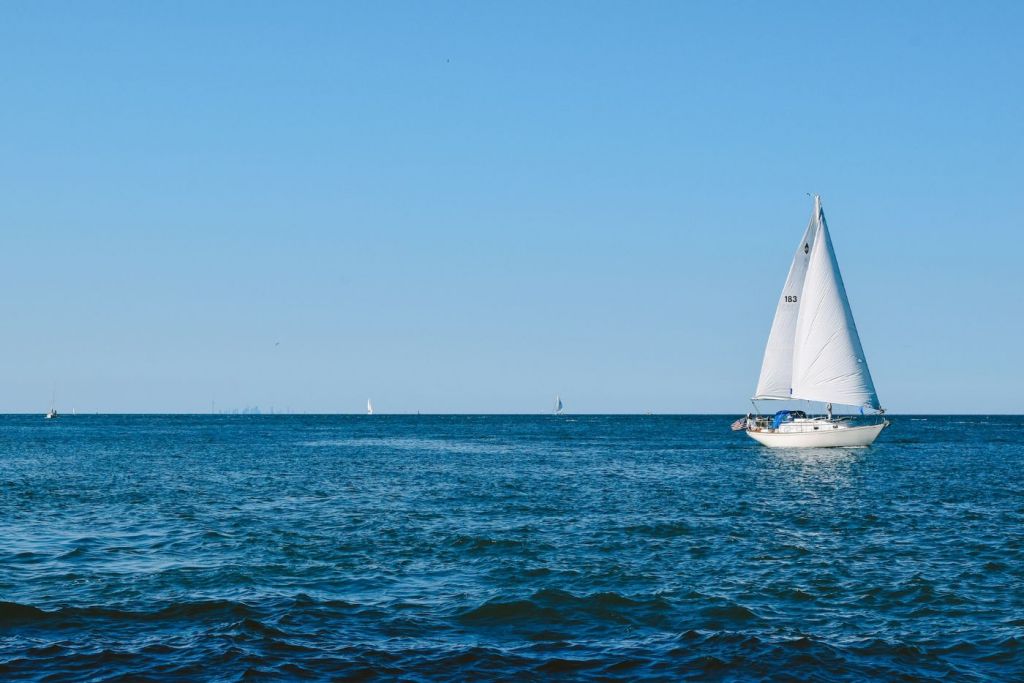
On this page:
Breakdown of costs in building a sailboat, average cost of building different types of sailboats, how to build a sailboat on a budget.
The average price range for building a sailboat from scratch is between $10,000 and $20,000 , but this can be much higher if you want to build an extremely high-quality craft or if you live in an area that is especially expensive.
Below is a table showing the estimated range of costs when building a sailboat:
Consider the materials you will use and the amount you need
Some common materials used in sailboat construction include fiberglass, wood, aluminum, and steel. The estimated cost of each material is as follows:
If you plan to build an aluminum sailboat, you might want to check out its pros and cons .
Factor in the costs of equipment
Building a sailboat requires a variety of specialized tools and equipment, such as saws, sanders, drills, and clamps. In addition to these basic tools, there are also more specialized pieces of equipment that may be necessary, such as a planer, a router, and a jointer. The table below shows how much each of these equipment costs:
Take into account the costs of labor
If you have the skills and experience to build the boat yourself, you can save a significant amount of money on labor costs. However, building a sailboat is a time-consuming process, and you should factor in the value of your time when calculating the overall cost of the project.
If you hire a professional boat builder, the cost of labor can be quite high, based on the complexity of the boat and the builder's experience and expertise. Although hiring a professional builder can be more expensive, it can ensure that the boat is built to high standards and is seaworthy.

Budget for purchasing a plan
If you are building a sailboat from plans, you will need to purchase the plans themselves. A plan refers to a set of detailed instructions and diagrams for building a specific sailboat design. It includes information on the materials needed for construction, as well as step-by-step instructions for assembling the boat.
Plans for a smaller, simpler sailboat may cost a few hundred dollars, while plans for a larger, more complex sailboat may cost several thousand dollars. The plan also includes the estimated timeline for completing the boat construction process. Building a sailing yacht can take at least 10 - 24 months to complete .
Carefully evaluate different sailboat plans before making a purchase to ensure that they are suitable for your needs and skill level. You may also want to consult with a professional boat builder or designer to help you choose the right plans and provide guidance during the construction process.
Account for miscellaneous expenses
There are a variety of other expenses which can add up quickly and should be factored into the overall cost of the project, such as the following:
- Permits: Depending on the location where the sailboat is being built, there may be permits required for construction.
- Insurance: Sailboats are valuable assets and require insurance coverage to protect against damage, loss, or theft. Insurance premiums can be a significant expense, especially for larger sailboats. Read this article to see the current costs of sailboat insurance.
- Transportation: If the sailboat is being constructed in a location that is far from the water, transportation costs may be incurred to move the boat to the water. This can include fees for a trailer, a truck, or a professional boat transport company.
- Miscellaneous Materials: There may be other materials required for the project that are not included in the initial cost estimate, such as hardware such as screws, bolts, and fittings, which may need to be purchased separately.
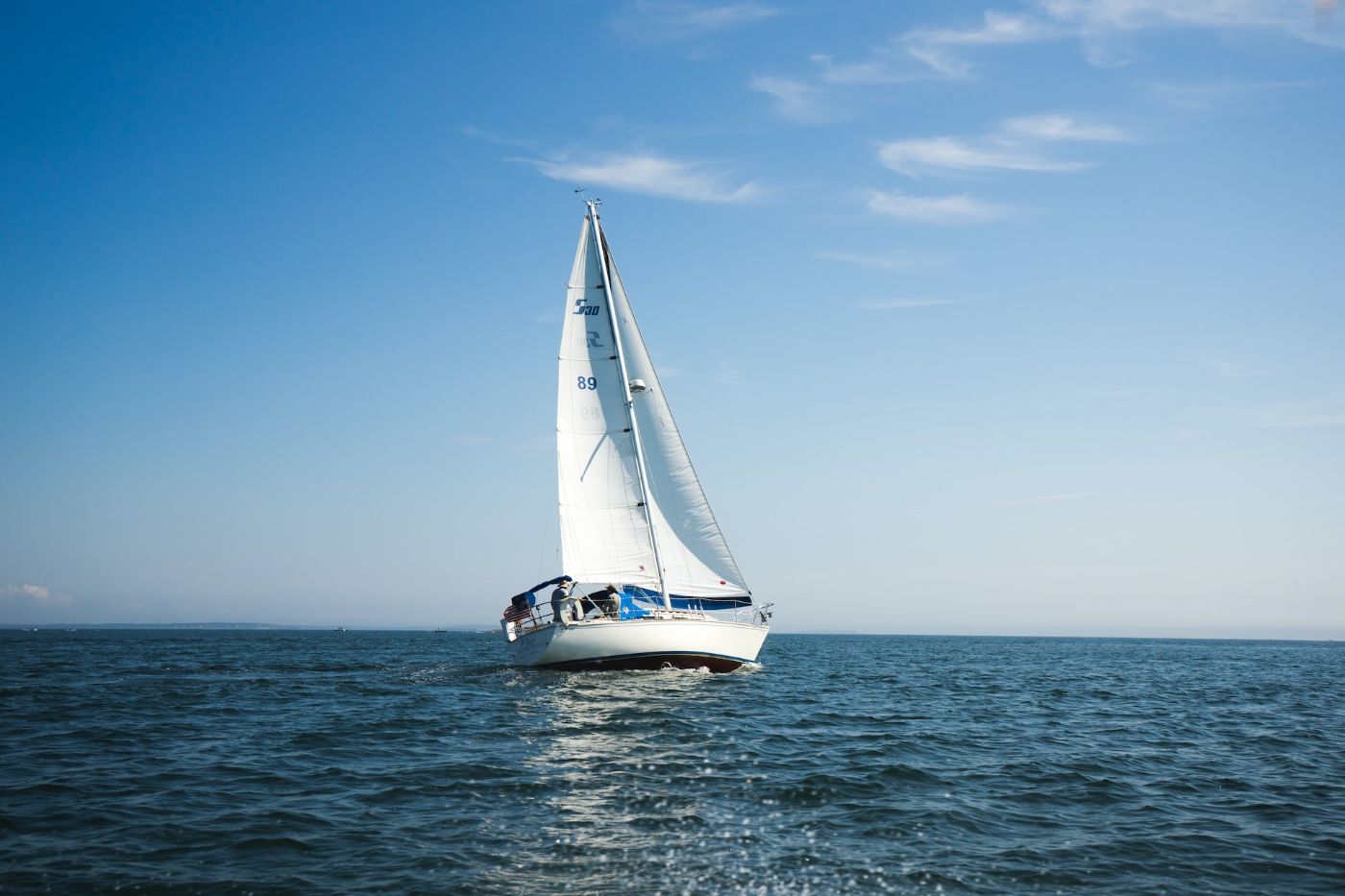
Sailboats come in various types, each designed with different features and purposes. The type of sailboat you choose will affect the cost of building it. Here are some common types of sailboats and their average costs:
The cost of building a dinghy
Dinghies are small sailboats that are typically used for racing or leisure sailing. They are usually less than 20 feet long and are designed to be sailed by one or two people.
For a basic dinghy, the cost can be as low as $1,500. This would typically involve using plywood or fiberglass for the hull, and basic rigging and hardware. However, for a more high-end dinghy, the cost can be as much as $10,000 or more. This would typically involve using high-quality materials such as carbon fiber or Kevlar for the hull, and more advanced rigging and hardware.
The cost of building a daysailer
Daysailers are slightly larger than dinghies and are designed for sailors who want to enjoy a day on the water without the expense and maintenance of a larger boat. Daysailers come in a variety of designs, from traditional wooden boats to modern fiberglass models. Some popular brands of daysailers include the J/Boat, the Laser, and the Sunfish.
These types of sailboats can accommodate up to six people and are usually between 20 and 30 feet long. A basic daysailer can be built for as little as $10,000, while a more luxurious model can cost upwards of $30,000. The most common materials used for building daysailers are wood, fiberglass, and aluminum.

The cost of building a cruiser
Cruisers are larger sailboats that are designed for long-distance sailing. The best-size cruiser usually ranges from 30 - 40 feet long.
Building a cruiser can cost between $30,000 and $100,000. Some cruisers may have additional amenities such as a kitchen, bathroom, and sleeping quarters, which can increase the overall cost.
The cost of building a racing sailboat
Racing sailboats are designed for speed and agility. They are usually between 20 and 30 feet long and are built with lightweight materials.
Building a racing sailboat can cost between $20,000 and $50,000, depending on the size and materials used. Since these sailboats are designed to be as lightweight as possible, it means that high-performance materials such as carbon fiber may be used, which can increase the overall cost.
The cost of building a catamaran
Catamarans are sailboats with two hulls. They are designed for stability and speed and are usually between 30 and 50 feet long, but the perfect size for sailing is around 37037 feet . Building a catamaran can cost between $50,000 and $500,000.
The larger the catamaran, the more expensive it will be to build. The materials used in the construction of the catamaran can also impact the cost, so if a catamaran is made of fiberglass, it will be less expensive than one made of carbon fiber. A catamaran with a more complex design or more advanced features will generally cost more to build.
The cost of building a trimaran
Trimarans are sailboats with three hulls, which are usually between 30 and 50 feet long. The cost of building a trimaran ranges between $50,000 and $500,000.
Since trimarans are generally larger and more complex than monohull boats, they require more materials and labor to build. Additionally, trimarans often require specialized equipment and expertise to construct, which can drive up the cost of the project.
Trimarans are also often built using high-quality materials like carbon fiber, Kevlar, and other advanced composites, which can be quite expensive. These materials are chosen for their strength, durability, and lightweight, which are all important factors for a high-performance sailing vessel.

Below are some tips to help you build a seaworthy sailboat without breaking the bank:
Consider a self-build kit : If you're handy with tools and have some building experience, you might want to consider a self-build sailboat kit. These kits come with everything you need to build a sailboat, including plans, materials, and hardware. Self-build kits can be a cost-effective way to build a sailboat, with prices ranging from $2,500 for a 17' sailboat kit to $14,000 to $18,000 for a Puur 17 kit, whichever you'd like to choose.
Choose your materials wisely : You don't want to skimp on quality, but you also don't want to overspend on expensive materials. With this, perhaps consider using plywood instead of solid wood for the hull, as it's more affordable and easier to work with. You can also look for deals on used materials, such as sails, rigging, and hardware, to save money.
Keep it simple : The more complex the design, the more expensive it will be to build. A simple design with a basic rig can be just as seaworthy as a more complex design, and it will be easier and cheaper to build.
Do it yourself : If you have the skills and experience, try doing as much of the work yourself as possible. This can include everything from building the hull to installing the rigging and hardware. Doing the work yourself can save you a lot of money on labor costs, and it can be a rewarding experience to build your own sailboat from scratch.
Leave a comment
You may also like, how long does it take to build a yacht (7 types).
Building a yacht requires time, effort, and dedication. Factors such as customization, size of the yacht, design complexity, material availability, and shipyard …
pros-and-cons-of-aluminum-sailboat

What's the Best Size of Sailboat for Coastal Cruising?
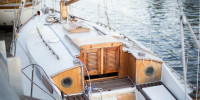
13 Best Beginner Sailboats with Cabin (For Any Budget)

The Best Sailboats for Rough Sea Conditions (13 Examples)
Own your first boat within a year on any budget.
A sailboat doesn't have to be expensive if you know what you're doing. If you want to learn how to make your sailing dream reality within a year, leave your email and I'll send you free updates . I don't like spam - I will only send helpful content.
Ready to Own Your First Boat?
Just tell us the best email address to send your tips to:
WOODEN BOW TIES
How to build a wooden sailboat: a beginner's guide.
Are you interested in building your own sailboat? If so, building a wooden sailboat can be a rewarding and fulfilling experience. Not only will you have a unique vessel to call your own, but you’ll also learn valuable woodworking skills along the way.
To get started, you’ll need to gather the necessary materials and tools. This may include oak plywood, epoxy resin and hardener, thickener, brad nails, masking tape, a pull-saw, and a table saw. Once you have everything you need, you can begin the process of building your sailboat. From creating a jig and frame assembly to making the mast, there are many steps involved in building a wooden sailboat. But with patience and attention to detail, you can create a beautiful and functional vessel that will bring you joy for years to come.
Understanding the Basics of a Wooden Sailboat
If you are interested in building a wooden sailboat, it’s important to understand the basics of how a sailboat is constructed. In this section, we’ll cover the parts of a wooden sailboat and the different types of wooden sailboats.
Parts of a Wooden Sailboat
A wooden sailboat is made up of several parts, each with its own unique function. Here are some of the most important parts:
- Hull : The hull is the main body of the boat. It is the part of the boat that sits in the water and provides buoyancy.
- Keel : The keel is a long, narrow fin that extends down from the bottom of the hull. It helps to keep the boat from capsizing by providing stability.
- Rudder : The rudder is a flat piece of wood or metal that is attached to the back of the boat. It helps to steer the boat.
- Mast : The mast is a tall, vertical pole that supports the sails.
- Sails : The sails are large pieces of fabric that are attached to the mast and other parts of the boat. They catch the wind and propel the boat forward.
- Boom : The boom is a horizontal pole that is attached to the bottom of the mast. It helps to control the shape of the sail.
Types of Wooden Sailboats
There are many different types of wooden sailboats, each with its own unique characteristics. Here are some of the most common types:
- Dinghy : A dinghy is a small sailboat that is typically used for recreational sailing or racing.
- Sloop : A sloop is a sailboat with a single mast and a fore-and-aft rig.
- Ketch : A ketch is a sailboat with two masts, with the main mast taller than the mizzen mast.
- Yawl : A yawl is a sailboat with two masts, with the mizzen mast located aft of the rudder post.
When choosing a type of wooden sailboat to build, it’s important to consider your needs and experience level. A dinghy is a good choice for beginners, while a ketch or yawl may be more suitable for experienced sailors.
By understanding the basics of a wooden sailboat and the different types available, you can make an informed decision about which type of boat to build.
Choosing the Right Materials
When building a wooden sailboat, choosing the right materials is crucial to ensure the boat’s durability and performance. In this section, we will discuss the two most important materials you’ll need to choose: wood and sails/rigging materials.
Selecting the Right Wood
Choosing the right type of wood for your sailboat is critical. You want a wood that is strong, lightweight, and resistant to rot and decay. Some of the most popular types of wood used in sailboat building include:
- Cedar: Lightweight and easy to work with, cedar is an excellent choice for planking and decking.
- Mahogany: Strong and durable, mahogany is often used for building frames and keels.
- Oak: A dense and hard wood, oak is commonly used for building frames and planking.
When selecting your wood, make sure it is free of knots, cracks, and other defects that could weaken the boat’s structure. You should also consider the wood’s grain pattern, as this can affect the boat’s strength and appearance.
Choosing Sails and Rigging Materials
The type of sails and rigging materials you choose will depend on the type of sailboat you’re building and your sailing needs. Some of the most common materials used in sail and rigging construction include:
- Dacron: A strong and durable synthetic material, dacron is commonly used for sailcloth.
- Nylon: Lightweight and flexible, nylon is often used for spinnaker sails.
- Stainless Steel: Strong and corrosion-resistant, stainless steel is commonly used for rigging hardware.
When selecting your sails and rigging materials, consider the conditions you’ll be sailing in and the type of sailing you’ll be doing. For example, if you’ll be racing, you may want to choose lightweight sails and rigging materials that will help you achieve maximum speed. On the other hand, if you’ll be cruising, you may want to choose more durable materials that can withstand rougher conditions.
By choosing the right materials for your wooden sailboat, you can ensure that your boat is strong, durable, and performs well on the water.
Designing Your Sailboat
Before you start building your wooden sailboat, you need to design it. This will involve creating a blueprint and determining the size and shape of your boat.
Creating a Blueprint
Creating a blueprint is an essential step in designing your sailboat. It will help you visualize your boat and ensure that you have all the necessary components in place. You can create a blueprint using software such as AutoCAD or SketchUp, or you can draw it by hand.
When creating your blueprint, consider the following:
- The length, width, and height of your boat
- The position of the mast and sails
- The location of the rudder and keel
- The number of cabins and their layout
- The placement of any storage compartments or equipment
Determining the Size and Shape
The size and shape of your sailboat will depend on several factors, including your budget, the type of sailing you plan to do, and the number of people who will be on board.
Consider the following when determining the size and shape of your sailboat:
- The type of sailing you plan to do (coastal cruising, racing, etc.)
- The number of people who will be on board
- The amount of storage space you will need
- The amount of deck space you will need
- Your budget
Once you have determined the size and shape of your sailboat, you can start gathering materials and building your boat.
Building the Hull
When building a wooden sailboat, the hull is the most important part of the boat. It is the main structure that holds everything together and keeps the boat afloat. Building the hull requires cutting and assembling the wooden frame.
Cutting the Wood
To begin building the hull, you will need to cut the wood into the appropriate sizes and shapes. The wood should be cut according to the plans or blueprints that you have created. You can use a saw or a jigsaw to make the cuts.
It is important to use high-quality wood that is free of knots or other defects. The wood should be strong enough to withstand the pressure and weight of the water. Common types of wood used for building a wooden sailboat include cedar, oak, and mahogany.
Assembling the Frame
Once you have cut the wood, you can begin assembling the frame of the hull. The frame is made up of vertical pieces of wood called frames, which hold the shape of the boat. The frames are attached to the keel, which is the main structure that runs down the center of the boat.
To assemble the frame, you will need to use a sawhorse or other support to hold the lumber in place. You can then use screws or bolts to attach the frames to the keel. It is important to ensure that the frames are level and straight.
After the frames are attached to the keel, you can add the planks to the hull. The planks are attached to the frames and keel using screws or nails. It is important to ensure that the planks are properly aligned and spaced.
Once the planks are attached, you can sand and finish the hull to give it a smooth and polished look. This will also help to protect the wood from the elements.
Building the hull of a wooden sailboat requires patience and attention to detail. With the right tools and materials, you can create a strong and beautiful hull that will last for years to come.
Installing the Deck and Cabin
Installing the deck and cabin of your wooden sailboat is a crucial step in the construction process. It not only adds to the aesthetics of your boat but also provides structural support. Here are some tips to help you through the process.
Deck Installation
The deck of your wooden sailboat should be installed after the hull has been completed and before the cabin is built. It is important to ensure that the deck is watertight to prevent any leaks. Here are the steps to follow when installing the deck:
- Cut the deck to fit the hull and sand the edges to ensure a tight fit.
- Apply a layer of epoxy to the hull and deck joint to seal it.
- Secure the deck to the hull using screws or bolts.
- Apply a layer of fiberglass cloth and epoxy to the deck to make it watertight.
- Sand the surface of the deck to prepare it for painting or varnishing.
Cabin Installation
The cabin of your wooden sailboat provides shelter and storage space. It is important to ensure that it is properly installed to prevent any leaks. Here are the steps to follow when installing the cabin:
- Build the cabin on a flat surface using marine-grade plywood.
- Cut the cabin to fit the deck and hull and sand the edges to ensure a tight fit.
- Apply a layer of epoxy to the cabin and deck joint to seal it.
- Secure the cabin to the deck using screws or bolts.
- Apply a layer of fiberglass cloth and epoxy to the cabin to make it watertight.
- Install any windows, hatches, or doors in the cabin.
- Sand the surface of the cabin to prepare it for painting or varnishing.
By following these steps, you can ensure that your wooden sailboat’s deck and cabin are properly installed and watertight. This will not only make your boat look great but also ensure that you have a safe and enjoyable sailing experience.
Setting Up the Mast and Sails
Now that you have built your wooden sailboat, it is time to set up the mast and sails. This process may seem daunting, but with a little patience and attention to detail, you can have your boat ready to sail in no time.
Step 1: Install the Mast
The first step is to install the mast. Depending on the design of your boat, the mast may be a single piece or assembled from multiple sections. Make sure the mast is secured properly and is straight. Use a level to ensure the mast is vertical in both directions.
Step 2: Prepare the Sails
Next, prepare the sails. Make sure the sails are clean and free of any debris or damage. Attach the sail to the mast using the halyard, which is a rope used to raise and lower the sail. Make sure the sail is hoisted all the way to the top of the mast.
Step 3: Attach the Boom
Attach the boom to the mast and secure it with a boom vang, which is a rope used to control the angle of the boom. The boom is the horizontal spar that holds the bottom edge of the sail.
Step 4: Set the Sail
Once the boom is attached, set the sail. Adjust the angle of the boom and the sail to catch the wind and start moving. You can use the main sheet to control the angle of the sail and the boat’s speed.
Step 5: Trim the Sail
Finally, trim the sail to optimize its performance. This involves adjusting the sail’s shape and position to maximize its power and minimize drag. Use the sail controls, such as the cunningham and outhaul, to adjust the sail’s shape. Use the main sheet to control the sail’s position relative to the wind.
Congratulations! You have successfully set up the mast and sails of your wooden sailboat. Now it’s time to hit the water and enjoy the thrill of sailing.
Applying Finishing Touches
When it comes to building a wooden sailboat, applying the finishing touches is a crucial step that can make all the difference in the final product. Here are some tips and tricks to help you get the perfect finish.
Sanding and Finishing
Before you can apply any finish, you need to make sure the surface is smooth and free of imperfections. This means sanding the wood with progressively finer grits of sandpaper until you achieve the desired smoothness. Once you’ve finished sanding, you can apply a wood conditioner to help the wood absorb the finish more evenly.
When it comes to choosing a finish, you have several options. Some popular choices include varnish, paint, and oil. Varnish is a popular choice for wooden boats because it provides a durable, glossy finish that can withstand the harsh marine environment. Paint is another option, but it requires more maintenance than varnish and may not provide as much protection against the elements. Oil is a good choice if you want a more natural look, but it may not provide as much protection as varnish or paint.
Painting and Varnishing
If you decide to go with paint or varnish, there are a few things to keep in mind. First, make sure you apply the finish in a well-ventilated area to avoid inhaling fumes. Second, make sure you apply thin, even coats and allow each coat to dry completely before applying the next. This will help prevent drips and ensure a smooth finish.
When it comes to varnishing, it’s important to use a high-quality brush and work quickly to avoid brush marks. You may also want to consider using a foam brush for hard-to-reach areas. Once you’ve applied the final coat of varnish, you can buff the surface with a soft cloth to achieve a high-gloss finish.
Painting requires a different approach. You’ll need to choose the right type of paint for your boat and make sure you apply it evenly. If you’re painting a large area, you may want to consider using a paint sprayer to achieve a smooth, even finish. Once the paint has dried, you can apply a clear coat to protect the paint and give it a glossy finish.
In conclusion, applying the finishing touches to your wooden sailboat is an important step that requires careful attention to detail. By following these tips and using the right tools and materials, you can achieve a beautiful, long-lasting finish that will protect your boat and make it stand out on the water.
Safety Measures
When building a wooden sailboat, safety should always be your top priority. Here are some safety measures you should take to ensure a safe and successful build.
Installing Safety Equipment
Before you start building, make sure you have all the necessary safety equipment installed in your workshop. This includes fire extinguishers, smoke detectors, and first aid kits. You should also have a clear and unobstructed path to the exit in case of an emergency.
When working with power tools, always wear eye and ear protection, as well as a dust mask to protect your lungs. If you are using chemicals, make sure you are working in a well-ventilated area and wear gloves and a respirator if necessary.
Conducting a Safety Check
Before you start working on your sailboat, conduct a safety check to make sure everything is in order. Check that all tools and equipment are in good working order and that there are no loose or damaged parts. Make sure your work area is clean and free of clutter, and that all cords and cables are properly secured.
When working with wood, be aware of any knots or cracks in the wood that could weaken the structure of your sailboat. Use only high-quality marine-grade wood and be sure to follow the plans carefully to ensure a strong and safe boat.
By following these safety measures, you can ensure that your wooden sailboat build is a safe and enjoyable experience.
Maintaining Your Wooden Sailboat
Congratulations on building your own wooden sailboat! Now that you have a beautiful vessel, it’s important to keep it well-maintained to ensure its longevity and safety on the water.
Regular Maintenance
Regular maintenance is essential to keep your wooden sailboat in top condition. Here are some tips to keep in mind:
- Clean your boat regularly with a mild soap and water to prevent dirt and grime buildup.
- Check for any signs of damage, such as cracks, rot, or loose fittings, and address them promptly.
- Apply a fresh coat of varnish or paint every few years to protect the wood from the elements.
- Keep your boat covered when not in use to protect it from the sun and rain.
Seasonal Maintenance
In addition to regular maintenance, there are also some seasonal tasks that you should perform to keep your wooden sailboat in top condition:
- At the beginning of the season, inspect the hull for any damage or wear and make any necessary repairs.
- Check the rigging and sails to make sure they are in good condition and make any necessary repairs or replacements.
- Before storing your boat for the winter, make sure to properly winterize it to protect it from the cold and moisture.
Additional Tips
Here are some additional tips to keep in mind when maintaining your wooden sailboat:
- Use high-quality marine-grade products when cleaning and maintaining your boat.
- Avoid using harsh chemicals or abrasive materials that can damage the wood.
- Regularly check the bilge for any water buildup and pump it out as needed.
- Keep your boat well-ventilated to prevent moisture buildup and mold growth.
By following these tips, you can keep your wooden sailboat in top condition and enjoy many years of safe and fun sailing.
Leave a Reply Cancel reply
You must be logged in to post a comment.

Step-By-Step Guide: How to Build a Wooden Sailboat – Complete DIY Tutorial
Alex Morgan
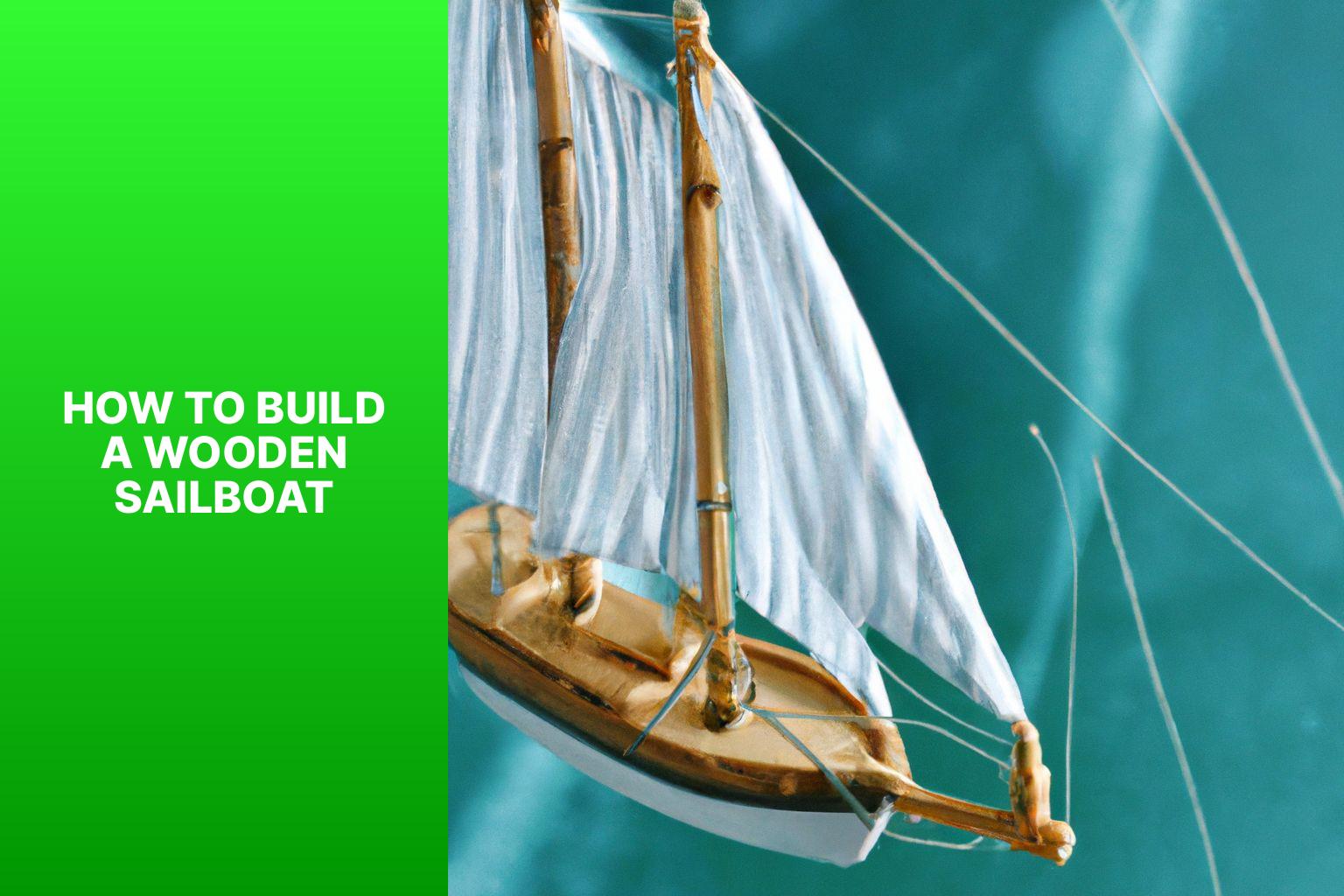
Building a wooden sailboat is a rewarding and fulfilling endeavor that allows you to create your own vessel for sailing adventures. Whether you’re a seasoned sailor or a woodworking enthusiast, constructing a wooden sailboat requires careful planning, attention to detail, and a love for craftsmanship. This comprehensive guide will take you through the step-by-step process of building a wooden sailboat, from choosing the right design and gathering the necessary materials to assembling the framework, building the deck and cabin, and installing the sails and rigging. We will also discuss the finishing touches and regular maintenance required to keep your wooden sailboat in optimal condition for years of enjoyment on the water. Let’s dive into the world of wooden sailboat construction and embark on this exciting journey together.
Key takeaways:
Key takeaway:
- Choosing the right design and plans is crucial: Research different sailboat designs and select suitable plans based on your skill level to ensure a successful project.
- Gather the necessary materials and tools: Pay attention to wood selection and preparation, as well as acquiring the tools and equipment needed for building your wooden sailboat.
- Attention to detail in the construction process is important: Prepare and assemble the framework carefully, focusing on lofting, laying out the keel, constructing the ribs, and the hull structure to ensure a sturdy and reliable sailboat.
Choosing the Right Design and Plans
When it comes to building a wooden sailboat, one of the crucial steps is choosing the right design and plans. In this section, we’ll take a deep dive into the world of sailboat designs and explore the vast array of options available. From researching different sailboat designs to selecting plans that match your skill level, we’ll guide you through the exciting process of bringing your wooden sailboat dream to life. So, hop aboard and let’s set sail on this exhilarating journey of craftsmanship and adventure.
Researching Different Sailboat Designs
When conducting research on sailboat designs, it is important to take into account a variety of factors in order to select the most suitable design. One of the primary considerations is whether you prefer a monohull or a multihull sailboat. Monohulls are more commonly found and offer superior performance when sailing upwind, whereas multihulls provide both stability and speed.
Another aspect to consider is your level of sailing experience. If you are a beginner, it is advisable to seek out designs that are easier to handle and forgiving. On the other hand, experienced sailors may gravitate towards performance-oriented designs that are ideal for racing or long-distance cruising.
It is crucial to think about how you intend to use the sailboat. Are you looking for a day sailer , a cruiser , or a racing boat ? Each design comes with its own set of distinctive features and characteristics.
Determining the appropriate size of the sailboat is another crucial step, which should be based on the number of people and activities you plan to have on board. You must also decide whether you prefer an open cockpit or an enclosed cabin .
To find the perfect sailboat design that aligns with your sailing goals and preferences, it is imperative to thoroughly research various options and take into consideration all of these factors. By doing so, you will be able to make an informed decision and select the ideal sailboat design.
Selecting Suitable Plans for Your Skill Level
When it comes to building a wooden sailboat, it is crucial to select suitable plans that match your skill level. This is important as it ensures that you have the necessary knowledge and expertise to effectively complete the construction. In order to help you with this, here is a table that outlines the different skill levels and the corresponding plans:
Choosing the right plans for your skill level is essential as it enables you to navigate the construction process smoothly, avoid any complications, and ultimately achieve the desired result. It is crucial to honestly evaluate your woodworking skills and then select plans that align with your abilities. Keep in mind that building a wooden sailboat demands patience , attention to detail , and a willingness to learn and improve your woodworking skills.
As a pro tip, if you are a beginner, it is advisable to start with simpler plans and gradually work your way up to more complex projects. This allows you to gain experience and confidence in your woodworking abilities over time. So always remember to select suitable plans for your skill level and enjoy the process of building your wooden sailboat.
Gathering the Necessary Materials and Tools
When it comes to building a wooden sailboat, gathering the necessary materials and tools is key . In this section, we’ll dive into the exciting world of selecting and preparing the right wood for your sailboat, as well as the essential tools and equipment you’ll need to bring your project to life. So, start sharpening your creativity and let’s sail away into the realm of wooden boat construction!
Wood Selection and Preparation
Incorporating the provided keywords naturally in the provided text:
1. Conduct research on the different types of wood used in boatbuilding, such as mahogany , teak , or oak . This will help you make an informed decision regarding the most suitable wood for your sailboat.
2. Determine the specific requirements of your sailboat design in order to guide your wood selection process. Each design may have different needs and preferences when it comes to the type of wood to be used.
3. Take into consideration the durability and resistance to rot of the wood options available. This is crucial to ensure the longevity and overall quality of your sailboat. Choosing a wood that can withstand exposure to water and other elements is essential.
4. Look for straight , dry , and defect-free wood. This will contribute to the structural integrity of your sailboat. Any defects or irregularities in the wood may compromise its strength and performance.
5. Calculate the amount of wood needed based on the specific design and measurements of your sailboat. This will help you estimate the quantity of wood required for the construction process.
6. Mill or cut the wood into the required dimensions and shapes as outlined in the sailboat design. This step is crucial for achieving the desired structure and appearance of your sailboat.
7. Prior to assembly, it is important to sand the wood surfaces thoroughly. This will remove any rough edges or splinters, ensuring a smooth and safe finish.
8. Apply a protective coating or sealant to the wood in order to prevent water damage. This will help preserve the wood and extend its lifespan .
By following these steps, you can ensure that the wood selected and prepared for your sailboat construction is suitable and of high quality.
Tools and Equipment Needed for the Project
When embarking on the construction of a wooden sailboat, it is crucial to have the appropriate tools and equipment to ensure successful completion.
To accurately measure and obtain precise alignment and dimensions, essential measuring tools such as a tape measure , combination square , and level are indispensable.
For shaping wooden components, cutting tools like a circular saw or table saw , jigsaw , and hand saw are necessary.
Joinery tools, including a chisel set , mallet or hammer , and drill with different-sized bits, are vital for smoothly joining parts together.
To achieve a polished finish, sanding and finishing tools such as sandpaper with varying grits, sanding blocks , and a random orbital sander are crucial.
Additionally, brushes and rollers are required for the application of finishes.
When it comes to safety, it is imperative to prioritize the use of safety goggles , ear protection , a dust mask , and work gloves to ensure personal protection during the construction process.
When selecting tools and equipment, it is essential to invest in high-quality items that are specifically designed for the tasks involved in wooden sailboat building.
By doing so, not only will efficiency be maximized, but the overall quality of the finished boat will also be greatly enhanced.
Preparing and Assembling the Framework
As we delve into the world of building a wooden sailboat, we now find ourselves in the exciting phase of preparing and assembling the framework. In this section, we’ll discover the essential steps that go into setting up the lofting and laying out the keel , as well as the intricacies of constructing the ribs and hull structure. Get ready to immerse yourself in the hands-on process of bringing this magnificent vessel to life!
Setting Up the Lofting and Laying Out the Keel
To properly set up the lofting and lay out the keel for a wooden sailboat, it is important to follow these steps in a systematic manner:
- Firstly, prepare the lofting area by clearing a large, flat space where the plans and measurements will be placed.
- Next, securely attach the keel stock to the lofting platform, making sure it is both level and aligned with the boat’s centerline.
- Using battens, rulers, and pencils, transfer the measurements and lines from the boat plans onto the lofting platform.
- Ensure the accuracy of the waterlines, buttock lines, and other reference lines on the lofting platform by drawing them according to the measurements provided in the boat plans.
- Utilizing the dimensions indicated in the plans, measure and mark the positions of the keel, stem, and transom on the lofting platform.
- Thoroughly examine and adjust all lines and measurements to guarantee their accuracy.
- Identify the locations where any additional frames, bulkheads, or structural elements will connect to the keel, by marking them accordingly.
- Prior to proceeding, double-check all marks and measurements to ensure their accuracy.
The process of setting up the lofting and laying out the keel is an integral step in the construction of a wooden sailboat. It serves as the foundation and reference points for the boat’s overall structure. It is crucial to pay close attention to detail and maintain accuracy throughout the build. By following these steps, you will be on your way to constructing your very own wooden sailboat.
Constructing the Ribs and Hull Structure
When constructing the ribs and hull structure of a wooden sailboat, follow these steps:
– Measure and cut the ribs: Use the plans as a guide to mark and cut the dimensions on the wood. Cut the ribs accurately.
– Attach the ribs to the keel: Position and attach the cut ribs evenly along the keel using marine epoxy and screws.
– Install chines and stringers: Attach the chines to the bottom edge of the boat and install the stringers along the sides for strength.
– Attach the planking: Cut and fit planks to cover the rib and stringer structure, securing them tightly.
– Reinforce the joints: Apply epoxy and fiberglass tape over the joints to strengthen the structure.
– Shape the hull: Use tools to shape and smooth the hull, paying attention to fairing for optimal hydrodynamics.
– Apply a protective finish: Coat the hull and ribs with marine-grade varnish or epoxy for durability.
– Perform a thorough inspection: Check for defects, cracks, or imperfections and make necessary repairs before moving forward.
The process of constructing wooden sailboats has evolved over time, combining traditional techniques with modern materials and tools. Craftsmanship, attention to detail, and an understanding of wood’s properties are still essential in constructing the ribs and hull structure. This blend of artistry and engineering ensures sailboats can withstand the demands of the sea while providing a smooth and enjoyable sailing experience.
Building the Deck and Cabin
Let’s dive into the exciting world of building a wooden sailboat! In this section, we’ll focus on the crucial element of constructing the deck and cabin. Get ready to explore the process of creating the deck framework and adding those essential interior features . From laying the foundation to crafting a cozy cabin space , we’ll uncover the key steps and considerations for bringing your wooden sailboat to life. So, grab your tools and let’s set sail on this exhilarating construction journey !
Creating the Deck Framework
When creating the deck framework for a wooden sailboat, follow these steps:
- Measure and mark the desired deck size and shape on the boat’s frame.
- Cut and shape the wooden planks or panels to match the marked measurements.
- Align the planks or panels horizontally across the frame, ensuring they are straight and evenly spaced.
- Secure the planks or panels to the frame using screws or nails, ensuring tight fastening.
- Add additional support beams or joists underneath the deck for added strength and stability.
- Sand the deck surface to create a smooth and even finish.
- Apply a weather-resistant sealant or paint to protect the deck from moisture and UV damage.
- Install necessary features or fixtures on the deck, such as hatches, cleats or railings.
Pro-tip: Enhance the deck’s strength and durability by adding epoxy or marine adhesive between the joints before securing the planks or panels.
Installing the Cabin and Interior Features
When building a wooden sailboat, it is important to pay attention to every step, including the installation of the cabin and interior features. To install these features, follow the following steps:
1. First, measure and cut the materials for the cabin walls, floor, and ceiling.
2. Next, securely fit the cabin walls in place.
3. Then, attach the floorboards to the cabin base using screws or nails.
4. Align and install the cabin ceiling.
5. If desired, add insulation for extra comfort.
6. Attach interior features such as cabinets, storage compartments, and seating areas.
7. Install windows and hatches to allow for natural light and ventilation.
8. Properly wire the cabin for electricity, ensuring that lights and outlets are installed and functioning.
9. Finish the interior by sanding and applying a protective coat of varnish or paint.
10. Ensure that all installations meet safety standards.
Precision and attention to detail are key when installing the cabin and interior features of a wooden sailboat. By carefully measuring, cutting, and fitting each component, you can ensure a secure fit. It is important to optimize the layout and functionality of the interior features to create a comfortable living space with ample storage. The addition of windows and hatches will enhance comfort and enjoyment by providing natural light and ventilation . If electricity is needed, proper wiring is essential to ensure necessary lighting and power outlets. Finishing the interior with a protective coat of varnish or paint will not only enhance aesthetics but also provide durability.
Remember, the goal is to create a cozy retreat for sailors, so it is important to put in the necessary effort to install the cabin and interior features correctly.
Installing the Sails and Rigging
Set sail with confidence as we dive into the exciting world of installing the sails and rigging for your wooden sailboat. Discover the key considerations in choosing the perfect sails and master the art of setting up and adjusting the rigging. With expert tips and tricks , this section will equip you with the knowledge to navigate the waters with ease and experience the thrill of sailing your wooden masterpiece .
Choosing the Right Sails
When choosing sails for your wooden sailboat, consider the following factors:
– Type of sailing: Determine if you plan to cruise , race , or do both. Different sails are designed for specific purposes.
– Boat size: The size of your sailboat determines the size and number of sails you need. Larger boats require bigger sails , while smaller boats may need fewer and smaller sails .
– Wind conditions: Consider the typical wind conditions in your sailing areas. Different sails perform better in light winds , heavy winds , or various wind conditions.
– Sail material: The material of the sails affects durability and performance. Material choices include Dacron , laminate , and nylon . Each material has different trade-offs between longevity, performance, and cost.
– Reefing options: If you sail in varied or unpredictable wind conditions, choose sails with reefing options. Reefing allows you to adjust the sail area for stronger winds, improving control and safety.
– Manufacturer reputation: Research sail manufacturers for their reputation and reliability. Read reviews, seek recommendations, and consider warranty and customer support.
By considering these factors, you can make an informed decision when choosing sails for your wooden sailboat. Remember, the right sails greatly impact your sailing experience, so take your time and choose wisely.
Setting Up and Adjusting the Rigging
When setting up and adjusting the rigging of a wooden sailboat, it is important to follow these steps to ensure proper and safe rigging.
To start, attach the mast to the deck using a mast step or mast partner for stability and support. This will provide the foundation for the rigging.
Next, secure the standing rigging , which includes the shrouds and stays , to the mast. This will help distribute the forces from the sails and ensure the stability of the mast.
Connect the forestay to the bow of the sailboat. This will keep the mast in line and control the position of the headsail.
To counteract forces from the headsail and maintain rigging tension, attach the backstay to the stern of the boat.
Use turnbuckles or rigging screws to adjust the tension in the standing rigging. This will ensure proper alignment and support of the mast.
Install the running rigging , including halyards and sheets , to control the position and tension of the sails.
Before and during sailing, it is important to regularly check the tension in the rigging to ensure performance and safety.
Make any necessary adjustments to the rigging during sailing in order to optimize the shape of the sails and enhance the performance of the boat.
By following these steps, you will be able to properly set up and adjust the rigging of your wooden sailboat, allowing for safe and enjoyable sailing experiences.
Finishing Touches and Maintenance
When it comes to completing your wooden sailboat and keeping it in top shape, this section has got you covered. We’ll dive into the art of applying exquisite finishes to the hull and deck, giving your sailboat a stunning appearance. And don’t worry, we won’t neglect the nitty-gritty details of regular maintenance and care, ensuring your wooden vessel remains seaworthy for years to come. So, let’s get ready to add those finishing touches and keep your sailboat sailing smoothly !
Applying Finishes to the Hull and Deck
When building a wooden sailboat, applying finishes to the hull and deck is crucial for durability and aesthetic appeal. Here are the steps to follow:
1. Prepare the surfaces: Sand down rough spots, fill in cracks and imperfections, and ensure a smooth and clean surface.
2. Choose the right finish: Consider the type of wood and desired look. Varnish provides a glossy and traditional appearance, while paint offers different colors and styles.
3. Apply the primer: Enhance adherence and create an even surface for the final coat by applying a primer.
4. Apply the finish: Use a brush or roller to apply the chosen finish coat to the hull and deck. Follow the manufacturer’s instructions for drying times and application techniques.
5. Allow for drying and curing: Follow the manufacturer’s instructions for drying and curing to ensure the finish is fully set and provides maximum protection.
6. Inspect and touch up: After drying, inspect the hull and deck for missed spots or imperfections. Touch up any areas that require additional finish for a seamless and polished look.
By following these steps and applying finishes properly, you can protect and enhance the hull and deck of your wooden sailboat, ensuring it looks beautiful and lasts for many years.
Regular Maintenance and Care for Your Wooden Sailboat
Regular maintenance and care for your wooden sailboat is crucial for its longevity and performance. Here are the steps to follow:
1. Inspect the hull and deck for damage like cracks or rot. Promptly repair any issues to prevent further damage.
2. Clean the boat regularly with mild detergent and freshwater to remove dirt, salt, and grime that can accumulate over time.
3. Apply a protective coating to the hull and deck using marine-grade varnish or paint to prevent water penetration and protect against UV damage.
4. Check the rigging and sails for wear or damage. Replace worn-out lines or rigging components for safe sailing.
5. Inspect wooden components such as the mast, boom, and rudder for rot or decay. Replace or repair as necessary to maintain structural integrity.
6. Keep the interior of the sailboat clean and dry to prevent mold and mildew growth. Use a dehumidifier if needed.
7. Regularly check and maintain the boat’s systems , including electrical, plumbing, and navigation equipment. Address any issues promptly.
8. Store the wooden sailboat in a suitable location, such as a covered boat dock or boatyard, when not in use. Protect it from extreme weather conditions.
Pro-tip: Establish a regular maintenance schedule and keep a detailed record of all maintenance and repairs. This will help you stay organized and ensure your wooden sailboat remains in optimal condition.
Some Facts About How To Build A Wooden Sailboat:
- ✅ Building a wooden sailboat can take approximately 100 hours over a span of 3 months. (Source: Instructables)
- ✅ A wooden sailboat can cost around $1,000 to build. (Source: Instructables)
- ✅ The boat is typically built from 4×8 sheets of plywood and measures 8 feet in length. (Source: Instructables)
- ✅ Various tools such as a pull-saw, table saw, router, sander, and drill are needed for building a wooden sailboat. (Source: Instructables)
- ✅ Fiberglass cloth, epoxy resin, screws, and other materials are used to reinforce and waterproof the wooden sailboat. (Source: Instructables)
Frequently Asked Questions
1. how long does it take to build a wooden sailboat.
Building a wooden sailboat typically takes about 100 hours spread over approximately 3 months.
2. What materials are needed to build a wooden sailboat?
To build a wooden sailboat, you will need 4×8 sheets of plywood, epoxy resin, oak plywood, various tools (such as a pull-saw, table saw, router, etc.), fiberglass cloth, screws, fasteners, and other supplies like glue, clamps, and mixing cups.
3. How much does it cost to build a wooden sailboat?
The estimated cost of building a wooden sailboat is around $1,000, including the materials and tools needed for the project.
4. Can I learn to build a wooden sailboat if I have no prior experience?
Yes, building skills can be learned gradually, and mistakes can be avoided along the way. With patience and guidance from boat building plans, even beginners can successfully build a wooden sailboat.
5. How long is the wooden sailboat described in the reference?
The wooden sailboat described in the reference is an 8-foot long pram, featuring classic lines and made from 4×8 sheets of plywood.
6. Can I launch the wooden sailboat in any body of water?
Yes, the wooden sailboat is designed to be light enough to fit in a small pickup truck or be rolled to a local lake on a dolly, making it suitable for various bodies of water.
About the author
Leave a Reply Cancel reply
Your email address will not be published. Required fields are marked *
Save my name, email, and website in this browser for the next time I comment.
Latest posts

The history of sailing – from ancient times to modern adventures
History of Sailing Sailing is a time-honored tradition that has evolved over millennia, from its humble beginnings as a means of transportation to a beloved modern-day recreational activity. The history of sailing is a fascinating journey that spans cultures and centuries, rich in innovation and adventure. In this article, we’ll explore the remarkable evolution of…

Sailing Solo: Adventures and Challenges of Single-Handed Sailing
Solo Sailing Sailing has always been a pursuit of freedom, adventure, and self-discovery. While sailing with a crew is a fantastic experience, there’s a unique allure to sailing solo – just you, the wind, and the open sea. Single-handed sailing, as it’s often called, is a journey of self-reliance, resilience, and the ultimate test of…

Sustainable Sailing: Eco-Friendly Practices on the boat
Eco Friendly Sailing Sailing is an exhilarating and timeless way to explore the beauty of the open water, but it’s important to remember that our oceans and environment need our protection. Sustainable sailing, which involves eco-friendly practices and mindful decision-making, allows sailors to enjoy their adventures while minimizing their impact on the environment. In this…
- Types of Sailboats
- Parts of a Sailboat
- Cruising Boats
- Small Sailboats
- Design Basics
- Sailboats under 30'
- Sailboats 30'-35
- Sailboats 35'-40'
- Sailboats 40'-45'
- Sailboats 45'-50'
- Sailboats 50'-55'
- Sailboats over 55'
- Masts & Spars
- Knots, Bends & Hitches
- The 12v Energy Equation
- Electronics & Instrumentation
- Build Your Own Boat
- Buying a Used Boat
- Choosing Accessories
- Living on a Boat
- Cruising Offshore
- Sailing in the Caribbean
- Anchoring Skills
- Sailing Authors & Their Writings
- Mary's Journal
- Nautical Terms
- Cruising Sailboats for Sale
- List your Boat for Sale Here!
- Used Sailing Equipment for Sale
- Sell Your Unwanted Gear
- Sailing eBooks: Download them here!
- Your Sailboats
- Your Sailing Stories
- Your Fishing Stories
- Advertising
- What's New?
- Chartering a Sailboat
How to Build a Boat
If you want to know how to build a boat you've come to the right place, because that's what we did, learning as we went. She's called Alacazam , and you can see her in action in the picture above, charging through the Caribbean Sea off Montserrat. And we're going to take you through the entire sailboat construction process...
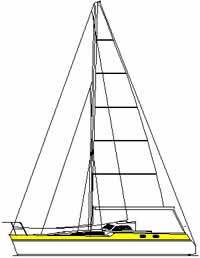
Jumping forward several years...
She was called 'Alacazam' , from the great Nat King Cole's song Orange Coloured Sky, and these are her vital statistics...
- Length overall: 11.5m (37.5 feet)
- Waterline length: 10.6m (34.5 feet)
- Beam: 3.9m (12.5 feet)
- Draft: 2.2m (7 feet)
- Displacement: 7,023kg (7.75 tons)
- Displacement/length ratio: 159
- Sail area/displacement ratio: 18.28
Of course you don't have to start from scratch as we did; there are a few other boat building options available that could save time and maybe cash too.
Whichever option you choose it's a very good idea to think the whole project through from beginning to end, as nothing can cause more disruption and additional cost than changing your mind halfway through a boat construction project.
It's an inescapable fact that cost and size are closely related, but not in a linear fashion as you might assume. If you double the length of the boat you're likely to increase the costs by a factor of four; and not just the build costs, but owning and operating costs too. Just wait until anti-fouling time comes around and you'll see what I mean.
Berthing costs seem to take a hike at around 12m (40ft) overall, and another at 15m (50ft), which was the final compelling factor in sizing our self-build cruising sailboat at 11.5m (38ft) on deck. This allowed for the anchor poking out at one end and the self-steering gear at the other, just in case any marina employee should get overzealous with the tape measure.
But where do you want to start? Here are your three main options:
- Buy an old, tired boat and completely refurbish her, or
- Buy a bare hull and deck moulding for home completion, or
- Start from scratch, and build the hull yourself.
We'll take a look at these three options in turn:
1. Starting With a 'Fixer-Up'
This can be a great option, particularly if you can get your hands on an old but tired pedigree boat with a proven reputation like the Ted Brewer designed Morgan 28 shown here - and you might just get it at an absolute knockdown price.
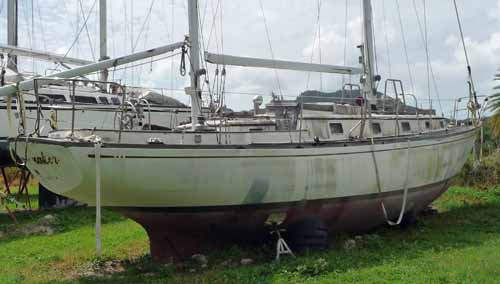
With luck, much of the interior will be salvageable, but you'll probably want to bring the instruments and electronics up to date, replace the rig and all the rigging, install a new engine and stern gear and replace the hatches and much of the deck equipment.
But you really should get a professional surveyor involved before you take up such a project. Explain to him carefully what your intentions are, and ask him to prepare his report with that in mind; it could save you a whole heap of time and money.
2. Starting from a Bare GRP Hull
This approach will get you off to a flying start, particularly if the hull comes with the deck moulding already fitted and the bulkheads bonded in. The problem will be in finding one, as few manufacturers seem to offer this once popular option these days.
3. Starting from Scratch
You need to take a very deep breath before setting off along this route - and believe me, I know, because this is how we built our custom designed sailboat Alacazam .
Unless you're building from an established set of boat plans, you'll be well advised to get a yacht designer involved at the outset.
And one of your first decisions will be the choice of hull material - fibreglass, steel, aluminium, ferro-concrete or wood - but which one, and why?
The Outline Requirements for our 'Ideal Cruising Sailboat'
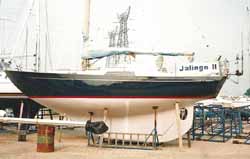
My current boat at the time was a Nicholson 32 Mk10. Jalingo was a narrow hulled, heavy displacement, long keeled cruiser that I'd sailed thousands of miles - much of it singled handed (until I met Mary, who put paid to all of that self indulgence) - off the shores of the UK, France, Spain and Portugal, and to the Mediterranean and back.
Her hull shape and displacement ( Jalingo's , not Mary's) meant that she was comfortable in a seaway and great in a blow, but sluggish in light winds - and that keel meant she was a nightmare to handle in the confines of a marina.
Like all long-distance sailors we had a good idea as to what our 'ideal cruising sailboat' would be. I've always thought that a cutter rigged sloop is the ideal the ideal rig for a cruising boat, with a roller furling jib , a hanked-on staysail (easy to replace with a storm jib when necessary) and a slab-reefing mainsail with lazy jacks , as I don't trust either in-mast furling or in-boom furling .
Additionally she would:~
- have high resistance to capsize;
- be robust and easy to maintain;
- have good performance under sail;
- have a comfortable, easy motion underway;
- be easily manageable by a small crew;
- have sufficient internal volume for comfortable living aboard;
- be affordable to own and operate.
Did we know how to build a boat with these desirable characteristics? No, but we knew a man who did. Enter Andrew Simpson, yacht designer, surveyor and shipwright - and one of my best chums...
The Designer's Proposals for our Ideal Cruising Sailboat
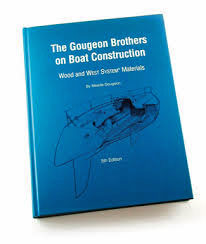
We discussed all this at length, and made a number of sketches of both the interior layout and an efficient, workable cockpit .
Andrew did the number crunching and came up with an outline design for a 38ft (11.5m) cutter rigged wood/epoxy (cedar strip) water-ballasted cruising boat.
"She'll be light, quick, robust and comfortable" he said
"And seaworthy?" we asked
"Eminently so" he replied
"Right" we said, "Let's do it!"
And so we did...
So How Did We Build Alacazam ?
Here's the whole story, in words and pictures.
How to Build a Boat:
- Part 1: The All-Important Preparation
- Part 2: How to Build a Boat Hull in Western Red Cedar
- Part 3: Sheathing the Hull in Woven Glass Rovings
- Part 4: Cutting and Installing the Plywood Bulkheads
- Part 5: Building the Interior Structure
- Part 6: Constructing the Deck and Coach Roof
- Part 7: Moulding the GRP Cabin Top
- Part 8: Fitting the Bulb Keel
- Part 9: Making the Rudder
Next: How to Build a Boat, Part 1
Recent Articles
'Cabo Frio', a Catalina Morgan 43 for sale
Apr 01, 24 08:35 AM
Live Aboard Boats For Sale
Mar 30, 24 07:02 PM
A Beneteau Oceanis 43 for Sale
Mar 30, 24 06:01 PM
Here's where to:
- Find Used Sailboats for Sale...
- Find Used Sailing Gear for Sale...
- List your Sailboat for Sale...
- List your Used Sailing Gear...
Our eBooks...

A few of our Most Popular Pages...

Copyright © 2024 Dick McClary Sailboat-Cruising.com
Sailboats embody the mystery of the sea, of going only where the wind is willing to take you. We offer a variety of sailboat sizes, using several construction techniques. We offer sails, hardware and rigging for many of our sailboat designs. This enables you to focus on building your boat, not searching around for all the bits and pieces needed to complete the project.
Free online book:
- Rigging Small Sailboats
- Sailboat Hardware Notes

Glen-L 25 - Plywood

Service Locator
- Angler Endorsement
- Boat Towing Coverage
- Mechanical Breakdown
- Insurance Requirements in Mexico
- Agreed Hull Value
- Actual Cash Value
- Liability Only
- Insurance Payment Options
- Claims Information
- Towing Service Agreement
- Membership Plans
- Boat Show Tickets
- BoatUS Boats For Sale
- Membership Payment Options
- Consumer Affairs
- Boat Documentation Requirements
- Installation Instructions
- Shipping & Handling Information
- Contact Boat Lettering
- End User Agreement
- Frequently Asked Questions
- Vessel Documentation
- BoatUS Foundation
- Government Affairs
- Powercruisers
- Buying & Selling Advice
- Maintenance
- Tow Vehicles
- Make & Create
- Makeovers & Refitting
- Accessories
- Electronics
- Skills, Tips, Tools
- Spring Preparation
- Winterization
- Boaters’ Rights
- Environment & Clean Water
- Boat Safety
- Navigational Hazards
- Personal Safety
- Batteries & Onboard Power
- Motors, Engines, Propulsion
- Best Day on the Water
- Books & Movies
- Communication & Etiquette
- Contests & Sweepstakes
- Colleges & Tech Schools
- Food, Drink, Entertainment
- New To Boating
- Travel & Destinations
- Watersports
- Anchors & Anchoring
- Boat Handling
- ← New & Used Boats
Yes, You Can Build Your Own Boat!
Advertisement
With a kit boat that requires no measuring or cutting, you can confidently assemble a seaworthy Polynesian-style catamaran.
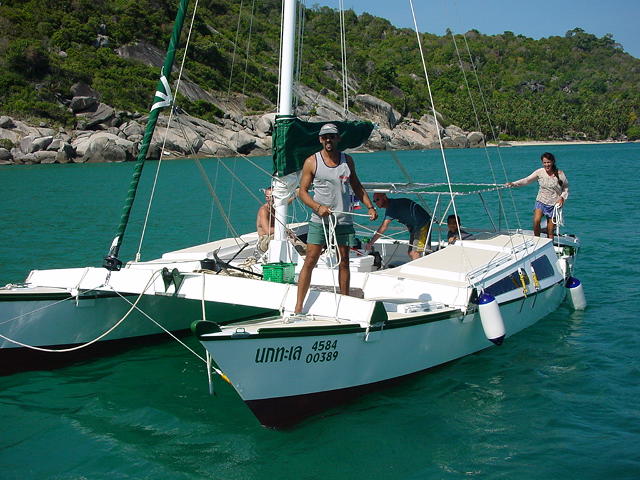
Want a new boat, but at an “old days” price? Rather than buying an old junker with the intention of fixing it up (when you can find the time), consider building your own boat. James Wharram, a British multihull pioneer and designer of plywood Polynesian-style catamarans ranging from 14 to 55 feet, is now offering the Mana 24 as a complete kit for $13,500.
Everything is included, even sails – the only thing you’ll need to buy is paint – so once you take delivery of the kit, you can start building almost immediately. Plywood parts are accurately cut on a CNC router so there are no fancy boat building joints required; everything essentially slots together so things start to take shape quickly, giving the newbie boat builder a confidence booster.
“Building time in the early stages is greatly reduced by the CNC cut plywood parts, which takes away all the worry of measuring and cutting and lets the builder assemble the hulls very quickly,” says Wharram .
He and his partner, Hanneke Boon, say they designed the boat specifically for home construction. A vee-shape below the waterline eschews the necessity for keels or daggerboards, allowing the boat to sail in shallow water or even be pulled onto a beach. Wharram estimates that finishing the boat to a high standard will take 750 hours, which may seem a lot of time, but as he notes, “You’ll have a brand new boat at the end, and the satisfaction of having built her with your own hands.”
BoatUS Members save at Boat Shows
Make sure to mark your calendars for two exciting events – the New England Boat Show, Chicago Boat Show, and Atlanta Boat Show. Don’t miss out on these incredible shows! BoatUS Members save 25% with code BOATUS25.
Here are the dates for each show:
Related Articles
The truth about ceramic coatings for boats.
Our editor investigates the marketing claims of consumer-grade ceramic coatings.
Fine-Tune Your Side Scan Fishfinder
Take your side-scanning fishfinder off auto mode, and you’ll be spotting your prey from afar in no time
DIY Boat Foam Decking
Closed-cell foam flooring helps make boating more comfortable. Here’s how to install it on your vessel
Click to explore related articles
Contributing Editor, BoatUS Magazine
A marine surveyor and holder of RYA Yachtmaster Ocean certification, BoatUS Magazine contributing editor Mark Corke is one of our DIY gurus, creating easy-to-follow how-to articles and videos. Mark has built five boats himself (both power and sail), has been an experienced editor at several top boating magazines (including former associate editor of BoatUS Magazine), worked for the BBC, written four DIY books, skippered two round-the-world yachts, and holds the Guinness World Record for the fastest there-and-back crossing of the English Channel — in a kayak! He and his wife have a Grand Banks 32.
BoatUS Magazine Is A Benefit Of BoatUS Membership
Membership Benefits Include:
Subscription to the print version of BoatUS Magazine
4% back on purchases from West Marine stores or online at WestMarine.com
Discounts on fuel, transient slips, repairs and more at over 1,200 businesses
Deals on cruises, charters, car rentals, hotel stays and more…
All for only $25/year!
We use cookies to enhance your visit to our website and to improve your experience. By continuing to use our website, you’re agreeing to our cookie policy.
- For Sale/Wanted
- Readers Tips
- Your Yarns.
- Restoration
- Miscellaneous
- DIY Boat Yards
- Boat Building
- Cabin Cruisers
- Free Boat Plans
- Begin Boating
- Boating Terms
- Ropes and Rigs
- Just for Fun
- Celestial Navigation
- Passage Planning
- Diagonal Scale
Sailboat Plans

Free Sailboat Plans
A selection of some of the Free Sailboat Plans (pdf) that were published in magazines such as “Popular Mechanics”, "Popular Science" and the "Boat Builder Handbook".
If you need help with lofting out the plans click here for an article here which should help.
- Open Dayboats/Dinghys
- Rowing Boats
Open/Dayboat, Free Sailboat Plans
Everyone who digs boating has heard of the Hobie Cat, the sleek little catamaran that burst on the scene and captured the attention of all the fast-action sailors.
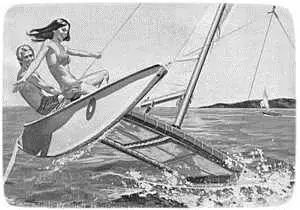
Marked by asymmetrical hulls and special trampoline supports, the Hobie can reach speeds above 20 mph and perform with a rare agility.
But it has one drawback.
It costs mucho dinero.
Thus, we introduce the Hobby Kat, sailboat plans, a build-it-yourself version of the “Hobie” that should cost from half to a third of the commercial version. If you have the moola, of course, go for a Hobie and have the time of your life on the water.
If not, try our Hobby
The homebuilt is not quite the same.
But she sails sweetly and fast—qualities which have made the “Hobie” popular
Even in a light air she’ll slip through the water at a fast clip.
She has no centreboards, leeboards or keel, and needs none.
The inside of each hull has built-in lift, like an airplane wing, so that as the boat heels and one hull digs in the boat is pulled back to windward.
Click Here for the Plans
She can run in very shallow water and the rudders kick up for beaching.
You can carry her on a trailer or even disassemble her.
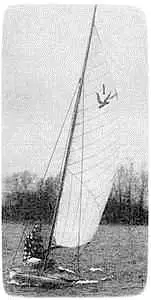
Many a “stink pot” addict will take a second look at Tern because she planes in modest breezes, is easy to handle, and her streamlined prow arid pod-shaped, “inland scow” type hull offer slight water resistance. Then too, there’s a charm about the tiller of a sailer that’s not matched by the wheel of a motor-powered boat. Part of it is the challenge of making the most of nature’s free-wheeling breezes. Even with her 72sq.ft of sail, this Free Sailboat Plan is remarkably stable, and packs as many as four persons aboard
For thousands of inland lakes, Tern is the answer to sailing water sport, she is rugged and easy to launch
And she’s remarkably easy to build.
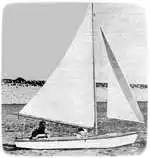
Falcon is a small, speedy, sporty sailboat which handles well. Tests on the original Falcon showed that she could easily out-distance boats of comparable size such as the one design class Snipe and Comet sailers.
And she will pace neck and neck with 18 footers with considerably greater sail spread.
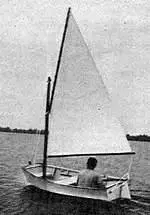
This strong, beamy, eight-foot pram may be sailed either cat-rigged or sloop-rigged.
The dagger-board may be adjusted forward to balance the helm when sailing with the addition of a jib sail.
Oars or a small outboard motor may also be used to power this versatile Free Sailboat Plans.
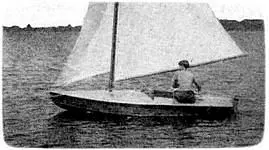
Dart” is a small two or three person sailing craft, designed for use on protected waters such as bays. lakes, rivers or wherever sheltered waters are found. Its construction will repay the builder handsomely and provide a fast sailing craft, light in weight, easily transportable and cheap to construct with all difficult joinery eliminated
It provides thrilling and economical sport.
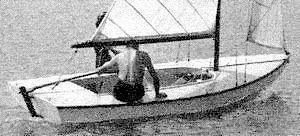
The 'Crescent', designed by C. T. Allen, is the ideal sailboat for day sailing on a small lake, river, or protected waters of a bay.
Centreboard design (Fig. 2) reduces Crescent's draft, so Shallow is not a problem.
Its broad beam of over 5½ft. makes it an ideal family boat because there is room for a cockpit large enough to accommodate four adults or two adults and three kids, and side and forward decks big enough to stretch out on when sun bathing.
"Jewel" is a 16' Crescent Sailboat being built by Mike Allen from the free sailboat plans by C.T .Allen in the 1958 "Boat Builders Handbook". And what a superb job Mike is doing check out his photos here .
Click Here for the Free version of the Plans
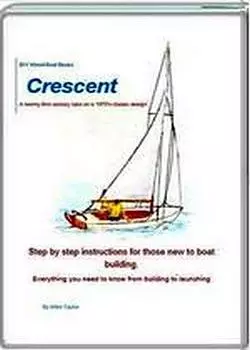
Sailing enthusiasts and backyard boat builders are not likely to find free boat plans for a sailing pram that can be built faster, lighter, stronger, or less expensively than Graefin-10. Two men can begin work on a Friday evening and have a smart, lively 10-ft. 85-pound sailboat in the water by Sunday evening (it’s been done).
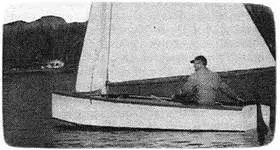
Zephyr Is a refinement of a type of boat developed by the English for use in the rough open waters of the English Channel. Not only is it fast under sail, but it can stand up under punishment. And it’s light enough to be easily loaded atop an auto or light trailer.
Breeze-Baby
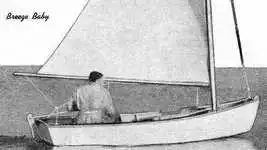
Skimming off a brisk wind or with the wind abeam, Breeze-Baby actually planes with one person aboard. Despite her rowboat lines that make her easy to build, she handles easily under her simple sail, an ideal first boat. Simple lines are adapted to plywood construction that’s strong, light and that keeps Breeze-Baby’s bilges dry
You can take her with you atop your car or on a lightweight trailer for summer fun wherever you vacation or get in a week-end’s sailing.
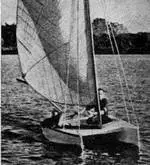
Cat’s Paw is easy to build because of the straight-sided hulls. The sheer line is flat and that simplifies building the form. Bow and stern are straight, so there’s no cockeyed bevel to fit and fuss with
She Is an Ideal boat to learn or practice sailing in because she will forgive so many mistakes.
Cabin Cruiser, Free Sailboat Plans
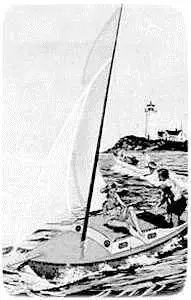
Previous posts
See What Others Have Posted

Recent Articles
WANTED: Long lost Chris Craft 26 feet
Jan 29, 24 01:35 AM

- Boat Plan Books
- Boatbuilding Tips
- Glass Cloth
- Stitch and Glue
- Strip Plank
You might like these

Plywood and Veneer Guide for Marine use.
A guide to plywood for boat building and why you should use the best marine grade you can afford.
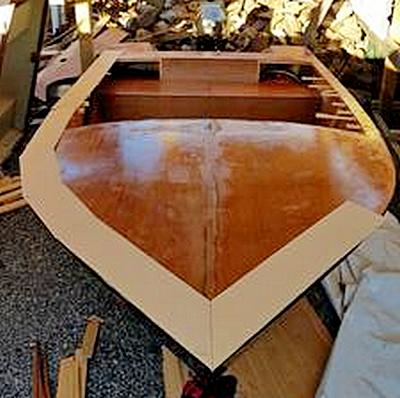
DIY Woodboat Building Questions
Woodboat building questions a Forum for wooden boat building, plans, lumber, caulking compounds and other boat building problems.

Boat Books for Wooden Boat Builders
Boat Books a series of boat books based on some of the 1960's, classic, Free Boat Plans that were published in magazines such as "Popular Mechanics", "Popular Science" and the "Boat Builder Handbook".

Build a Boat, tips for the DIY Wooden Boat Builder.
How to Build a Boat, Wooden Boat Building methods for the DIY, backyard, self-builders explained, carvel, lapstrake and plywood
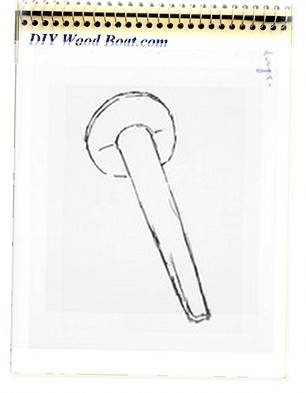
Clench Nails, Fastening for Small Wooden Boats.
How to use Clench Nails, these provide a fast reliable method for fastening small wooden boats.

Wood Screws for Boat Building and Repair.
Wood Screws are the most widely used and versatile fasteners used on wooden boats. Which type to use and how to use them
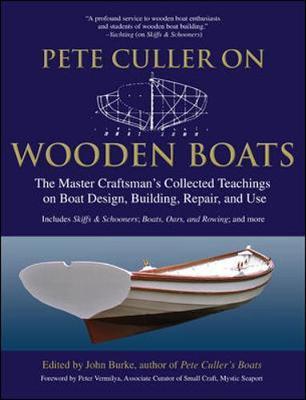
Timber, Lumber for Boat Building.
A brief description of the most common Timber used for building Wooden Boats how to choose wood for your project boat

Timber Properties
A brief guide to timber properties and wood, characteristics such as strength, stiffness and elasticity for choosing lumber for wooden boat building and restoration.
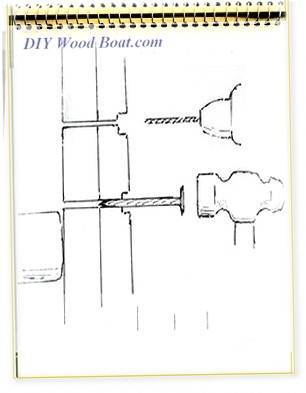
Rivets and Copper Rove Wood Boat Fastenings.
How to use Copper Rivets and Roves construction guide to fasteners on your wooden boat.

Ring Nails for Marine Fastening.
Ring Nails sometimes call Gripfast or ring shank, silicon bronze boat nails are renowned for their holding power. but how to get them out?

Free Motorboat Plans
Free Motorboat Plans for the backyard home builder, build your own speed boat, cabin cruiser, runabout or utility boat using these simple plywood designs.
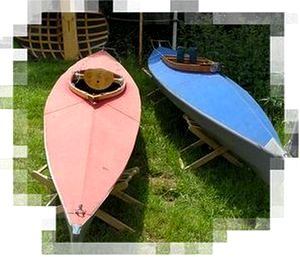
Wooden Boat Kits.
Wooden boat building is easy and inexpensive with wooden boat kits. From row boats and kayaks to sailing cruisers, boat to be proud of

Supplies for Wooden Boat building and Maintenance
Supplies for Wooden Boat Building and restoration, how to choose the materials and marine chandlery for your project.

DIY Woodboat Questions
Woodboat questions and answers forum for all Wooden Boat owners, advice and opinions on all aspects of wooden boat building, restoration and maintenance.

Small Boats, Made of Wood
What Everybody ought to know about building Small Boats, guidance and tips for self-building or restoring.
HELEN M HOBART
Jan 21, 24 05:31 AM
Drain plug for wooden hull
Dec 28, 23 11:28 AM
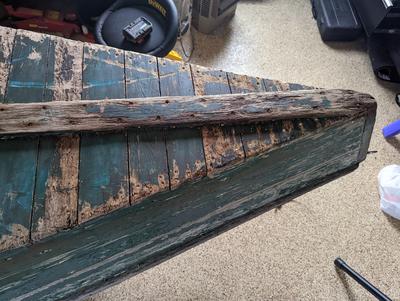
Woodboat Restoration questions forum
Woodboat restoration questions Forum, get advice about your Wooden Boat problems in a free, no frills, no need to sign up forum

Epoxy Resin for DIY Wooden Boat Building.
A guide to the epoxy resins and sustainable enrtopy resins to use when building wooden boats with marine plywood.

Wood Rot Repair and Treatment
Wood rot in wooden boats, how to treat, repair and replace rotten timbers in a wooden boat
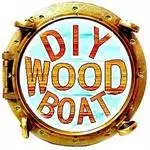
Privacy Policy
Advertising Policy
Cookie Policy

I am perfectly aware that the majority of Wooden Boat aficionados are sensible folk. However, I need to point out that I am an amateur wooden boat enthusiast simply writing in order to try to help other amateur wooden boat enthusiasts. And while I take every care to ensure that the information in DIY Wood Boat.com is correct, anyone acting on the information on this website does so at their own risk.
Build Your Own Boat
Myboatplans 518 boat plans.

More Information
This program was created by Martin Reid for all boat enthusiasts and aspiring sailors who wish to be on the waters with their own boats. Martin is a master boat builder with 31 years' experience in this field. He developed a passion for boats while he was young. An introduction to a master boat builder helped Martin a lot. Furthermore, He needed strategies to build boats to supplement the skills from the master boat builder. However, the plans were not efficient, and this resulted in Martin creating the My Boat Plans Program. My Boats Plan is an online program that teaches boatbuilding skills. This program provides detailed information on how one can own a boat without spending thousands of dollars. Worry not if you have no boatbuilding experience because My Boats Plans are the ultimate solution. Techniques are properly arranged for one without knowledge of designing boats to understand. In this program, you will find strategies to build 518 boats. Therefore, the choice of building your dream boat will remain personal. The tool is made by an individual with a boatbuilding passion from childhood. This guarantees you a reliable guide created by an experienced person. Interestingly, all 518 boat plans are unavailable in other sources. This renders My Boat Plans program unique and special. Transform your boat owning desires today into reality using this program. Continue reading...
Myboatplans 518 Boat Plans Summary
My boat plans by martin reid review.

I started using this book straight away after buying it. This is a guide like no other; it is friendly, direct and full of proven practical tips to develop your skills.
I give this ebook my highest rating, 10/10 and personally recommend it.

Block Island Cow Horn Boat Plans
Pieter van Storn, formerly of Island Water-world, and Malcolm Maidwell and Peter Spronk, of Caribbean Catamaran Centre, were most helpful in the Sint Maarten area. Hans Hoff, from the 90-foot ketch Fandango, is one of the few people who has won a bet from me on anchorages. The standing bet is I will buy a drink for anyone who can find a good, safe anchorage with 6 feet of water in it that has not been mentioned in the cruising guide. I expect to be nabbed once in a while by a small boat, but not by the skipper of a 90-foot ketch Hans found an anchorage inside the reef on the north coast of Anguilla. Where the chart showed nothing but solid reef, Hans managed to find himself inside the reef with 40 ffeet of water Numerous other skippers have, over the years, given me a tremendous amount of help. They include, in the Antigua area, Desmond Nicholson, of V. E. B.
An Interclub Racing Dory

As the refinement of the Swampscott dory type reached its zenith, the need arose to depart more distinctly from the workboat origins where rowing was as important as sailing and to develop a dory type specifically for sailing in interclub races. And, as John Alden never failed to appreciate the trends of his time, he set Sam Crocker, then in his employ, to work on a sailing dory one-design class in early 1921. The result was a beautifully modeled 21-footer with a marconi rig that carried 350 pounds of inside ballast. William Chamberlain built the first boats (and many of the rest), which were first sailed in 1921 at Marblehead's Eastern Yacht Club. So successful were the boats that other clubs ordered more built, and the Indian class was well on its way. The Indian is built dory-style, with the bottom, stem, transom, and six sawn frames being set up first.
You can have a sloop or a yawl trunk cabin or pilothouse

Ted Brewer has done a good job of creating a traditional-looking but trailerable character boat that has some good things going for it. One thing we especially liked is the optional mizzen mast with a 31-square foot sprit-rigged balancing sail. Mast and all can be pulled out like a weed and stored on deck when not in use or the sail can just be furled in place by wrapping around its tiny mast. The yawl in the sail-plan, also available as a sloop, was available either as a cen-terboarder (dimensions above) or as a shoal keeler with a 2' 6 draft (as shown in phantom lines in the profile drawing). A tropical version adds extra elliptical bronze ports and a

Rigging a twohanded dinghy

Every dinghy is rigged in a slightly different way and you should familiarize yourself with the manufacturer's instructions for the dinghy you are handling. The rigging sequence shown here is an example of how to rig a typical two-handed dinghy. select a flat location with the dinghy parked securely on its trailer and sufficient space all around. Check for overhead cables and other obstructions. Lay out the mast, boom, and rigging components. The mast may be fitted with a separate wire forestay to attach to the bow on dinghies with roller furling systems the forestay is provided by a luff wire built into the jib. If there is no conventional forestay, attach a rope temporarily. Ensure that each wire is led 1 Prepare the dinghy for rigging on its trailer or dolly, with clearworking space all around. When possible, choose a day with light wind. Two people are needed to rig the boat. In light wind, a small aluminum mast can be lifted to a vertical position by one person.
Rig sloop cutter yawl or ketch

Yawl-rigged boats are always easy on the eye this beautiful, tradinional yacht was moored in Newport, Rhode Island in 1996 The cutter rig probably provides the best compromise between good steering and uncomplicated boat-handling. It can be trimmed to balance just about every kind of boat and the distribution of the sail area over several relatively small sails makes boat-handling fairly straightforward even for small crews. Cutter-rigged masts also have a considerable safety advantage the two additional stays, the backstay and the cutter stay, significantly reduce the risk of dismasting, a real confidence-booster in extreme conditions.
Early Cape Dory offering by way of Allied Boat Co

George Stadel Cape Dory Yachts 1972-1982 264 sq. ft. portable portable This boat started life as the Allied Boat Company's Greenwich 24 (see page 268), but Allied sold the design and the molds to Cape Dory in 1972, when the company was beginning to add cruising boats (Carl Alberg's CD Typhoon 18 (19) in 1967, Ted Hood's CD 30 in 1971) to its daysailer offerings. Cape Dory modified the hull somewhat, raising the freeboard a bit to get more headroom (which added seven inches to her length on deck and the same amount to her waterline length), moving the head from between the forward V-berths to its own space on Cape Dory 25 Mk I 24' 10 7' 3 3' 0 3,850 1,500
Two Chesapeake Skiffs

Chesapeake Bay sailing crab skiffs can, with little alteration, make fast and able daysailers. These skiffs first appeared on the big estuary during the last years of the nineteenth century. The type perhaps we should say types varied wildly from creek to creek. Depending upon local conditions and prejudices, an observer at the time would have found single- and two-stick rigs, with or without headsails. Deadrise amidships (amount of V to the bottom) ranged from 0 degrees to about 12 degrees. Hulls were double-ended or transom-sterned. In fact, the diversity in skiff design allowed watermen to identify a boat as the product of a particular county, if not a particular builder. In addition to serving as their name suggests, the skiffs earned their keep in general waterfront transportation and by handling odd jobs. Although these boats went extinct half a century ago (at least as working watercraft), many of their characteristics survive in contemporary Chesapeake outboard-powered skiffs.
Tortured Plywood Boat Plans

Schooner and Flashboat Stability should be no problem if you're accustomed to canoes, kayaks, or high-performance pulling boats. This boat will feel tender at first, much in the manner of a light dory, but she'll seem to stiffen once you're settled down on the rowing thwart. Additional loading (say, a compatible passenger and a picnic lunch) will make her even more solid. At low and moderate rowing effort, the Flashboat will pull much in the manner of a Whitehall easily and with good carry though you'll notice her light weight. The revelation will come when you pour on the power. Pulled with sufficient vigor, a typical rowing boat eventually will dig itself a hole in the water and fall into it. No matter how hard you row, you'll go no faster a textbook demonstration of hull speed. Plans for the 15-foot Schooner and Flashboat are ai from Paul Gartside, 10305 W. Saanich Rd., RR 1, Sidney, BC, V8L 3R9, Canada. Particulars Schooner Particulars Schooner Schooner and Flashboat
How Are Catamaran Masts Fixed Down

Most masts on production multihulls are fixed, non-articulating, aluminum extrusions and are therefore preferred for their reliability. Shroud, forestay and leach tensions are counteracted by the compression of the mast on the central crossbeam, necessitating this critical zone to be one of the strongest structures on a catamaran. Loads are measured in tons. In some recent mishaps, high-strung and under-built America's Cup racing monohulls broke in half because of these massive rig forces. below The absolute best way to attach shrouds to a multihull. Aramid lashings are very strong, extremely reliable and easy to visually inspect. We should also look at rotating masts which, if properly designed, have advantageous applications even on a cruising catamaran. As we have seen, multihull masts must cope with a large range of loads. Since momentary rig forces can be 50 higher than on monohulls, the entire rig and its support system must be stronger.
A biglittle boat designed by William Garden

This design started off as a graceful catboat, the James W. Hart. To gain space for accommodations, a keel was substituted for the cat's large centerboard, a small fin was added forward to aid in coming about after the board was removed, and a snug sloop rig was chosen for simplicity and ease of handling. Dual steering stations and 6' 2 headroom under the big-windowed pilothouse completed the transformation. Best features The accommodations offer great comfort for two. The furniture is mostly single function so, for
Trinidad For Boat Building
Trinidadians have been building boats for years, especially power boats and fishing boats both for export and their own use. Bowen Marine, Formula III and Peake all have a good reputation in the power boat market, including fine cruising boats and some very fancy racing craft that, in the wrong hands, would raise the eyebrows of any customs officer from here to Miami. The sailing yacht market is newer. Soca Sailboats have a factory on the Eastern Main Road in Trinidad where they build Henderson 30 racing boats, as well as occasional custom boats. One of their craft Crash Test Dummies , a Henderson 35, cleaned up in the Caribbean racing circuit for a year or two. Last news was they were trying to sell it and build something even taster. They have an impressive factory with their own heating oven for building carbon fiber masts and they mold their own Samson Boats in San Femando build a variety of custom boats from fishing pirogues to giant cats.
Take your choice catboat or sloop

25' 8 (cat), 31' 8 (sloop) 21' 4 2' 0 5' 5 38' 6 25' 8 (cat), 31' 8 (sloop) 21' 4 2' 0 5' 5 38' 6 The Marshall 22 catboat and her sloop-rigged sister have been in production for over 40 years one of the longest running continuously produced cruising sailboat designs ever. During the period, understandably, the builder has made many changes. Gasoline engines have been replaced with diesels, horsepower ratings have crept up, interior layout has been modified (the bottom layout shown being the current version), and fit and finish have gone through several iterations (generally toward fancier wood trim). Still, the Marshall 22 remains essentially the same boat it was in 1965, featuring shallow draft (two feet with board up) for gunkholing or lying on the bottom at low tide, and a good length on deck for a catboat. (Hoisting the sail on a bigger cat can be a pain for a singlehander and a smaller cat has a lot less space below.
Catamaran vs Monohull

In order for us to appreciate the advantages of a catamaran it is important to be aware of their different attributes as compared to their ballasted counterparts. Although both types of vessels rely on watertight hulls to safely separate seawater from precious cargo on the inside, their stability is achieved via totally different means. Data of a typical 45' monohull will be compared to a 45' cruising catamaran, illustrating the diverse characteristics of both types of boats. Why are multihulls generally faster and do people really get less seasick sailing them In this chapter we objectively investigate advantages of catamarans such as their stable and spacious environment, low draft and the fact that beginner sailors feel more confident. But be aware, not everything is all roses. Although the well-designed and -built cruising multihull provides many rewards in terms of safety and handling, we will also investigate some of their drawbacks.
The Age of Exploration Carrack and Caravel

In the early fifteenth century the pace of ship development in the Atlantic tradition began to pick up this was the period with the most intense development of sailing ships. I hinted earlier about the potential for ship growth (in size) and development should the northern clinker and the Mediterranean carvel designs fuse. Such a mixing began with the Crusades. Many northern knights headed for the Holy Land in their double-ended clinker-built ships, taking them into Mediterranean ports en route. Better ships led to increased trade further afield, which contributed to the mixing of ship-building ideas so that, instead of two separate strands, Europe became a melting pot of diverse ideas concerning ship design. One of the first fruits of this melding of ideas, and certainly the best-known and most successful ship of its day, was the carrack. rig sails were good at running before the wind, while the Mediterranean lateen sail permitted tacking and yielded better control.
Replacement for the Cape Dory

Carl Alberg Cape Dory Yachts 1981-1985 304 sq. ft. 13 gal. 20 gal. Carl Alberg Cape Dory Yachts 1981-1985 304 sq. ft. 13 gal. 20 gal. Cape Dory Yachts decided to start from scratch on a new 25-footer after sales on their existing product, the CD 25, designed by George Stadel (see page 329) began to taper off. They hired Carl Alberg to come up with a bigger, heavier, more powerful boat capable of cruising two in comfort on extended cruises. Alberg eliminated the traditional forward V-berths and put in their place something not often seen in a boat this size a head with vanity, wet and dry hanging lockers, and a really rare feature, a shower. Also included are an L-shaped galley, two settee berths amidships (with one convertible to a double), and a quarter berth to starboard. Headroom is 5' 11 , very good for a boat only 25 feet on deck. A single-cylinder 8-hp Yanmar is standard.
A traditional cruising sloop made in Delaware

Designer-marketer John Kaiser of Greenville, Delaware, offered a number of fiberglass sailboats back in the early 1960s, including the cruiser shown here, built to his specifications by Plastic Fabricators, Inc. of Wilmington, Delaware. In his sales brochure, Kaiser says that it is the intention of the designer to produce a small, able, and comfortable cruising-racing sloop of superior quality in every detail. The brochure also states that while the
Catamaran sailing downwind

One of the main principles to bear in mind when sailing a catamaran on a downwind course is that you should never sail directly away from the wind. Instead, you have to sail a zigzag course, known as tacking downwind (see below). Because a catamaran achieves very high speeds on a broad reach-far higher than on a run-it is worthwhile sailing from one broad reach to another and jibing across. Although most monohulls also sail faster on a broad reach than on a run, it is not worth tacking a monohull downwind because the speed gained on the reach is not sufficient to compensate for the extra distance travelled. Provided you remember to keep the wind on the beam and adjust your course accordingly you will keep the boat sailing on the fastest course downwind. scale, it can be seen that there is a greater speed difference between a broad reach and a run (A-B) with the catamaran than with the one-design.
Tacking and jibing a catamaran

Catamarans tend to tack and jibe more slowly than monohull dinghies, but provide better stability. This is particularly noticeable when jibing, which is comparatively easy to control. The technique for both maneuvers is very different from a center mainsheet dinghy. In a catamaran, the helmsman should steer into the tack with the rig powered up and the boat sailing at speed. Steer carefully through the tack be aware that slamming the rudders over can make them act as brakes. Both crew should stay on the windward side until the jib has As you start to tack, keep the jib backed in order to help turn the bows, as catamarans are often slow to turn through the wind. Highperformance catamarans with daggerboards can pivot more quickly through the turn. backed. This will help to lift the leeward hull, so that the catamaran pivots on the inside hull. Keep both the mainsheet and jib sheet pulled in tight until the jib starts to back and the bows bear away on the new tack.
Featured Catamaran Listings
We Can Sell Your Catamaran Visit ur website for our extensive catamaran listings. - WoiId Champion Catamaran Sailor .Author of Si* Catamaran Books www.multihullcompany.com ANNAPOLIS FORT LAUDERDALE PHILADELPHIA TORTOLA Phone 610.617.0500 Fax 610,617.9358 e-maiJ infofa multihulkompany.com
Sailing A Schooner Rig

The fore-and-aft schooner rig consists of two masts and three principal sails, viz. a mainsail, which is, in fact, a gaff-sail fitted with a boom a spencer, or fore-sail, which is fitted with a gaff, but (generally) without a boom and a stay-sail, which is the leading sail, and is set on the fore-stay. In addition to these sails, schooners sometimes cany topsails, jibs, and flying-jibs. When a jib is used, a jib-boom has to be run out Schooners of a larger class are fitted with square-rigged topsails in some vessels on the main-mast only, in others on both masts. These vessels are termed square-rigged schooners, and square-topsail schooners, and sometimes square-headed schooners. The schooner rig is, unquestionably, the very best, safest, and handiest of any for large yachts and it is, besides, a favourite rig for large open pleasure boats, particularly those of a long and narrow form of hull, with sharp bows.
Multihulls Catamarans

Catamarans have a relatively long length along the waterline and no ballast at all, and consequently hold a straight line very well. The pressure on the rudder is relatively low as well, so they are easily steered. They accelerate far faster than monohulls in the puffs, however, which causes dramatic fluctuations in the apparent wind angle. The same is true in the lulls they slow down quickly and the wind swings aft. The principle is as follows when a gust hits a monohull, it causes increased heel and minor acceleration and the apparent wind swings forward only a little. A multihull is unaffected by heel but accelerates quickly the apparent wind angle swings forward markedly. This explains why catamaran sailors have always relied almost exclusively on autopilots. However a windvane system can be useful on extended voyages. Servo-pendulum systems can produce perfect steering on catamarans. The great speed potential allows the pendulum rudder to generate substantial steering force.
Sailhandling Monohull vs Multihull

Sailing trim on a catamaran does not differ greatly from that on a monohull, yet to a large extent it will depend on your experience, the actual boat you sail, and your perspective. Since the basic sailing concepts apply to multihulls as well, you'll find the experience similar to monohull sailing with subtle but important differences. Those new to the sport have few preconceptions about how a multihull should perform. They find multihulls relatively easy and forgiving boats to learn on as they aren't trying to subdue years of monohull sailing instincts. Becoming proficient at sailing in general, and at sailing a multihull in particular, become one and the same. While experienced monohull sailors have a firm foundation in basic techniques they need to get over the mindset of comparing multihull sailing to sailing one-hulled ballasted boats. Once they can do that the process is easy.
Schooner and Flashboat
Fs there one among us who has never lusted after a schooner For sailors confined by necessity or choice to small craft, the pursuit can be particularly frustrating. Paul Gartside has drawn a solution for the problem a 15-foot cold-molded daysailer beach cruiser that will let you have your schooner and trailer it, too. Though it lacks the majesty of the schooner-yacht America or the great fishing schooners, his design displays grace in full measure. Admired for its beauty but maligned for what are perceived as technical deficiencies, the schooner rig is not often selected for contemporary designs. As may be, Gartside's boat will withstand fairly rigorous assault by logic. The divided rig breaks the sail area into small, easily handled patches, and, as stability won't be this hull's strong suit, the low center of effort will be appreciated. The foresail might prove just close enough to the main to improve the airflow around the larger sail.
Rigging a singlehanded dinghy

Popular single-handed dinghies such as the Laser, Topper, and Pico all have similar rigging, which is simple and quick to assemble. With practice, you should be able to get one of these boats rigged and ready to sail in about 15 minutes, though you may need help lifting the mast. The principal feature of all these dinghies is that they have no shrouds or forestay to support the mast. Instead, the mast is self-supporting, with the lower part fitting into a tubular mast step in the foredeck. The unstayed mast does not provide the same level of control as a fully stayed rig. it will bend and flex with the wind, but it maintains sufficient stability for the helmsman to manage the sail. Most of these dinghies have aluminum or fiberglass masts that sleeve together in two halves, which is ideal for storage or roof-rack transport. instead of being pulled up a track in the mast, the sail has a luff sleeve that slides over the mast.
Principles of Yacht Design Sen

The ultra light dinghy type racing A medium value of Loa Lwl for modern yachts is 1.23 with a spread of 0.15 up and down. There is no discernible trend with hull length. The YD-40 is very close to the median L0A LW , is 1.22. hull length. Obviously this is due to the requirements of the accommodation. Even on very small yachts headroom for moderately tall people is required. The trend is shown in Fig 5.36, which shows the freeboard forward versus the waterline length. No upper and lower limits arc given, since the statistical basis for this graph is smaller than for the others above (only about 50 yachts).
Is she a sloop or a cutter

A syndicate in Annapolis, MD, calling themselves Blue Water Boats, commissioned Thomas Gillmer to design this perky small cruiser back in 1961, when they announced the boat would be supplied with mildew-proofed Egyptian cotton working sails. Ah, how times have changed The rig, incidently, shows a big masthead genoa as well as a 3 4 fractional rig with a diamond strut that looks as though it could poke a hole in the genny if it were trimmed in tight. It's not clear whether a buyer had to choose one sail or the other. In other words, is she a sloop or a cutter The prominent doghouse provides clear headroom of 5' 7 under its roof, and 8 inches less forward under the trunk cabin.
Sloop built in Tennessee then Texas

The vessel shown here started out in 1975 as the North American 23, built by North American Yachts in Hender-sonville, TN. But by 1978 she was being built in Austin, TX, as the Spirit 23, after a lawsuit was threatened by the builders of the North American 40, a Detroit firm totally separate from both North American Yachts and Glastron, the parent of Spirit Yachts, which built the Spirit 23 in Austin, TX. The Spirit line of sailboats was designed by Robert Finch, who also designed the Parker Dawson 26 Nauset 26 (page 364) and with Frank Butler had a hand in some early Coronado and Catalina Yacht designs including the ever-popular Catalina 27. The later Spirit 23s were available
Principles of Yacht Design Ena

Locally, the situation is quite different and the waves arc highly dependent 011 the shape of the hull. Within distances of a few hull lengths, waves from all points on the hull surface will in theory contribute to the wave system. Some of the points are, however, more important than others, since the disturbance is larger. For a sailing yacht the high pressure regions at the bow and stern are dominant, and it is usually assumed that only two wave systems exist (see Fig 5.14). Humps and hollows may be more or less pronounced, depending on the hull shape. For many sailing yachts they are very small in the lower speed range, but the last hump is still important. The slope of the curve gets very large just below this speed and to get over the hump is difficult. If this can be achieved, however, the increase in resistance becomes more gradual, and the hull enters the semi-planing speed range.
St Francis 50 Mkii Catamaran

St Francis Marine is one of the oldest boatyards in South Africa that manufactures catamarans, having built the first boat back 1988. Last year the yard celebrated its 50th launch with its new flagship, the St Francis 50, considered a high-quality world cruiser. She features the same attention to detail as her smaller sistership, the popular 44. The yard's innovative thinking in designing basic gear, such as the
Fairhaven Shipyard and Marina Ne Bdfcsd Harbor

Fairhaven Shipyard and Marina 50 Fort St. For over one hundred years Fairhaven Shipyard and Marina has been hauling, repairing and maintaining yachts of historical distinction. The shipyard and marina is home to the largest marine travelift in the U.S.A. and is capable of lifting vessels over 300 tons and 150 feet in length. This giant lift can transport both older and modern vessels with ease and safety. The professional staff represents over 150 years of experience. The shipyard staff takes great pride in their accomplishments in the field of marine repair and preservation. The marina personnel welcome visiting yachtsmen. Fairhaven Shipyard is a strategically located marina close to the center of historic Fairhaven, beaches, lodging, and restaurants. We are just across the harbor from New Bedford, with its quaint New England atmosphere. Fairhaven Shipyard and Marina is the first marina on the starboard side inside the Hurricane Breakwater.
How Much Payload Do A Cruizing Catamaran Need

Attached as the following episode, reported by famous multihull sailor Tony Bullimore, illustrates. He sailed a 60' racing monohull in heavy weather I was just sitting on my favorite seat by the galley, and it was really nice for a couple hours, and I thought, 'well, everything is OK, I'm going to just ride through it.' Then, all of a sudden, there was a crack, literally like, CRACK. It happened, quickly and instantly. Within two seconds, the boat was upside down. I was saying 'please turn back, come on, come on, and get upright.' Then when she wouldn't come up, I realized the keel had gone. Bullimore is still not sure exactly why the keel on his 60' monohull racer failed. He says it was as though all the forces just combined to be right at that split second, like a perfect karate chop, which is what it sounded like. The keel was not bolted to the bottom of the boat in the usual way, but was fitted through a slot in the hull and fixed to a false floor.
Catamaran Sailboat Wide Bodied Hulls

From the schematics at the top of page 117, one can easily see how the wetted surface of each type of hull section differs, yet retains the same cross-sectional area. At one extreme, the deep V-type hull partitions, as employed by the Wharram catamarans, have 25 more wetted area than the contemporary type oval and semicircular hulls. Although the V-type sections offer excellent resistance against pounding and travel efficiently through the water, they are poor load carriers and are rarely used in today's industry. At the other end of the spectrum, the semicircular and not to take sharp entries to the extreme, as they can create a lot of waves that reach higher and farther aft, often compromising the bridgedeck clearance issue. Deeper hull sections will have a motion that is gentler and less jerky than a full-bodied, flat-bottomed hull. In contrast, flatter sections will resist the heeling forces of the wind and pitching motion far better.
Storing and transporting a dinghy

You can leave a dinghy on its dolly at the beach or in a boat park or marina and transport it by road on a trailer. For peace of mind and for everyone's safety, the boat should be tied down as securely as possible, with top and bottom covers for maximum protection. STORiNG A DINGHY When leaving a dinghy unattended, you may need to remove sails, foils, and all loose fittings dinghy gear is expensive to replace and theft does unfortunately happen. Pull halyards tight before you leave the boat when it is windy, people do not want to hear the unpleasant noise of wires banging against aluminum masts. Leave the drain bung open to allow air to circulate inside the hull. It makes good sense to remove the bung or carry spares, in case a neighboring boat owner decides to borrow it. Always use a good-quality top cover to protect the dinghy from ultraviolet light and rain, and make sure it is securely attached to the boat a boom-up design will help drain rainwater away from the dinghy.
Catamaran launching and landing

Two hulls mean that a special technique is needed to launch or retrieve a catamaran on its dolly. Once on the water, the catamaran provides the crew with an extremely stable platform as they prepare to leave the beach or come in from sailing. LAUNCHING A CATAMARAN As with any dinghy, you should rig the sails of a catamaran as close to the water as possible. A catamaran dolly has two wheels on a central axle, with supports for the twin hulls. To put the dolly in 1A catamaran is rigid enough the balance point of the twin hulls, push the catamaran into the water until it is deep enough to float. Then remove the dolly. CATAMARAN LAUNCHING AND LANDING Landing a catamaran is usually simple if the sand is soft you can even sail up the beach. Control your speed as you come ashore, and watch for swimmers. Keep the rudders down to maintain control if you do not lift them in time, they will knock up on impact with the
Introduction to catamarans

Small beach cats, such as the Hobie 16 featured in this section, require slightly different techniques from sailing a dinghy. While all the principles of wind, balance, and trim are the same, Go for speed is always the golden rule for catamaran sailors. ANATOMY OF A CATAMARAN Look at the photographs on this page, and it will become clear why catamarans can sail so fast. Both crews are flying the windward hull, with just the leeward hull in the water. That super-slim hull has much less wetted surface area than any dinghy, which means there is far less drag. In addition, each of these catamarans has a beam of 8 ft (2.43 m), which is wider than any conventional dinghy hull (although not as wide as some high performance dinghies fitted with wings or racks). The beam of a catamaran gives a crew with twin trapezes a huge amount of leverage, which allows them to sail with a bigger rig than a similar length monohull.
Dinghy racing courses
All dinghy races have the same elements and rules, designed to ensure that everyone enjoys safe sailing while battling for position around the course. Marker buoys ( marks ) indicate where to turn, with start and finish lines marked by a committee boat. end of the start line manages the countdown to the start. The object is for boats to cross the line as soon as possible after the starting signal. The first leg is normally a beat to the windward mark. On a windward-leeward course (below) the boats have a short beam reach to a spreader mark, then sail downwind to the leeward mark close to the start line. Classes with symmetrical spinnakers will sail directly downwind classes with asymmetric spinnakers and catamarans will sail downwind on a series of broad reaches. The race may continue with more circuits of the course, usually finishing close to the windward mark at the top of the course.
Folkboat design imported from Hong Kong

Cheoy Lee Shipyard Cheoy Lee Shipyard of Hong Kong built various versions of this Folkboat-type hull (note similarities to the Contessa 26 on page 337) between 1957 and 1970, some in wood, others in fiberglass. The Mk III vessel pictured here was available either with a teak hull and teak superstructure, or with a fiberglass hull and teak decks and cabinhouse. The Mk III is distinct from the Mk I and Mk II mainly because of her doghouse cabin, which was possibly the idea of British designer Arthur Robb, though Tord Sunden is generally credited with the basic hull design. In any case, the boat won accolades for her good performance on transpacific and transatlantic voyages. Best features The Cheoy Lee artisans were well-known for their intricate teak carvings dragons and such with which they decorated the Flyer cabins, giving a luxurious effect.
Bimini Solid Cover For Catamaran

The Manta 42 is an evolution of the successful 40-footer which established the Florida company at the forefront of the US cruising catamaran market. Perfectly adapted to short-handed sailing, she features a unique camber-spar jib which is self-tacking. Unlike most production multihulls the Manta 42 has a laminated forward crossbeam, which is arched well over the waterline to reduce impacts in heavy seas. A very substantial stainless-steel aft-arch structure is available, which acts as antenna supports and dinghy davits. The Manta 42's solid bimini has integrated solar panels and spans the entire cockpit. Unique features include outside louvers, which keep solar radiation to a minimum and contribute to onboard comfort of this popular catamaran.
Evolution Of Boat Design

Between 1893 and 1914, the Herreshoff company designed seven advanced, powerful racing sloops. Five won the right to defend the America's Cup, and all five vanquished the challenger. Besides these majestic yachts, Herreshoff created a whole range of day boats and small yachts. The dominant yacht designer of the 20th century was another American, Olin Stephens. His reputation was established by the 51-ft (15.5-m) yawl Dorade, winner of the 1931 and 1933 transatlantic races. Influential on MIRROR DINGHY In the 1950s, Ricus van de Stadt of the Netherlands challenged the accepted wisdom that rudders should be hung on the trailing edge of the keel to reduce wetted surface and boost performance. The combination of separate hydro-dynamically efficient keels and rudders, coupled to the light plywood construction of the 39-ft (12-m) Zeevalk, foreshadowed the adoption of the fin and skeg hull design. Van de Stadt was one
Boat Handling under Power

Sometimes a need arises to spin a vessel in her own length, or not much more. If your boat is unusually athletic and you are of the sort of disposition which peers unflinchingly into the cannon's mouth, you may still get away with a power turn, particularly if you can arrange your affairs so that she is swinging with the propeller. Most times, such a bold approach is better turned down, either to ease the strain on your heart or, more usually, because the yacht simply won't swivel tightly enough without help. In either case the answer is the short turn (Fig 6.2). disappointed, and there's another point if you know what she'll do, you can often control circumstances to minimise, or even neutralise, the effects of her wickedness. If you know your boat will go on shoving her stern to starboard for 30 yds (27 m or so), try to give her a solid sheer the other way before you start. The two may have cancelled out by the time the rudder gets a grip.
Climbing aboard a dinghy

Dinghies, as we explain in Chapter 1, are smaller boats (usually under 20 feet, or 6 meters) that carry no ballast (weight) in their movable centerboard (underwater fin). Dinghies can also tip over. Because with this book we want you to master sailing and not swimming, make sure that your first step into a dinghy is as near to its centerline (an imaginary line that runs down the center of the boat from end to end) as possible, near the midpoint from bow to stern (front to back). (If you're not careful, you may tip the boat and end up in the water.) If the dinghy has wire rigging (shrouds) connecting the mast (near or at its top) to the right and left sides of the boat for support, you may want to gently hold on for balance and to keep the boat near you as you step on board. You may also want to consider starting from a sitting or crouching position on the dock. In any case, keep your weight as low and close to the centerline as possible as you step aboard, as Figure 4-3 shows.
Ketch Schooner Yawl Cutter

Staysail schooner Staysail schooners have sails set forward on stays. A mainsail is sometimes set on the main mast (below). Staysail schooner schooner Staysail schooner Staysail schooners have sails set forward on stays. A mainsail is sometimes set on the main mast (below). Staysail schooner schooner Square-rigged ships, particularly suited to sailing downwind, traversed the oceans by exploiting the steady trade winds. In European and other coastal waters, where winds are more variable, square sails were combined with fore-and-aft rigs. These latter rigs, which set the sails lengthways along the boat, were more suited to windward sailing. Barques and barquentines, brigs and brigantines, snows, schooners, ketches and yawls plied the coastlines. Each exploited its special advantages, whether of speed, ease of handling, cargo-carrying capacity, or of maneuverability in narrow channels. In most parts of the world, the old work boats are no longer employed.
Rigging Of Caravel Pinta

The caravel The management and staff of the Museu Maritim at Barcelona, for help in searching out material from the archives, particularly photographs the Director of the Museo Naval at Madrid, who allowed me, some years ago, to take photographs at the museum, and also allowed the use of material from books and documents in the museum my friend Manuel Ripoll, who supplied an old photograph of Guillen's Santa Maria (his father, a doctor in the Navy, was the ship's doctor aboard the replica) and Antonio Jaen, draughtsman, who was able to provide me with a copy of a lines plan which was no longer in print. His father had drawn the plans of the Santa Maria and the caravels for the Martinez-Hidalgo project. This is, unfortunately, far from being the case with the ships of Christopher Columbus. There is now no technical information available on how ships were built in Spain in the fifteenth century.
Cs 40 Sailboat Review

The next day was Friday, the eve of the Antigua Classic Yacht Regatta, so it was time to run back down to Falmouth Harbour, where competitors and spectators had been gathering for days. We anchored and took the dinghy on the first of several yacht-ogling cruises around the harbor. The classics, both original and reproduced, take your breath away. My personal favorite was Cambria, a gleaming, white-hulled, 23-Meter-class cutter that was built in 1928 and recently refurbished to qualify for the exclusive J-class association. Just down the dock was Velsheda, the 1933 J-class sloop that was brought back from the scrapheap to its current state of varnished perfection. Next door was Ranger, a recently commissioned 136-foot, steel-hulled re-creation of the so-called super Js that raced in the 1930s. At 200 tons, with a mast reaching 178 feet above the deck, she's a lavish, teak-decked combination of power and grace.
Asymmetrical Racing Hulls Catamaran

In order to make specific recommendations concerning the various multihull configurations, we must establish a working definition. We shall always refer to the weight-carrying hull as the hull and the float (or ama) as the outrigger. As a general rule, outriggers should be as light as possible and should not be used for stores and certainly not for accommodation. A catamaran is a configuration of two identical hulls, or, in the case ofassymetrical hulls, mirror images. In the daysailing sizes, catamarans are faster than trimarans owing to their ability to fly the windward hull and sail on one hull at a modest angle of heel. We shall discuss this question of hull flying further in Chapter 4.
If Your Boat Springs a Leak
Most leaks aboard fiberglass and aluminum boats result from malfunctioning through-hull fittings or hoses for bait wells and wash-down systems, and are not large enough to overcome the pumping ability of the bilge pump. However, for safety's sake, it's a good idea to carry some rubber stoppers that will plug your ittings in case something goes wrong with the valve or hose.
Alden Caravelle Sloop

By far the best Hylas 44 we have ever seen. Constantly upgraded including new Norseman Boom furling in '99, new mainsail, new staylock rigging in '98. Liferaft, RIB dinghy OB, 4.5 Northernlight genset, W D, Watermaker, The list goes on. She is near perfect. Asking 239K A great boat & a great deal, all the gear, Caribe dinghy, OB, 7.5 Gen, A C, Stainless ports, W D, low hour 75hp Yanmar Diesel, in-boom furling main, all furling sail system. Pullman cabin forward. Queen berth aft. Stall showers, swim platform. See Jordanyachts.com. Asking ONLY 330K. World Cruiser with roller furling mainsail, rebuilt 85hp Perkins, many recent upgrades. Two cabins, two heads with large after cabin. Great boat and a great price. Asking 99K
Taking the Dinghy through Surf
The gleaming white beach is a few yards ahead. I am studying the rise and fall of the sea from just outside the surf line, where the swell of the ocean feels the bottom and begins to break on the beach. Linda, seated in the stern of our nine-foot (2.8 meter) Dyer fiberglass dinghy, is relaxed, anticipating the children's joy. Elyse and Sarah, ages two and five, sit in the forward seat in their life jackets, gripping the gunwale with one hand and their buckets and shovels with the other. Just offshore Intermezzo stands quietly at anchor, a gentle swell occasionally lifting her stern. I give a light heave on the oars, and we coast forward. Now, eyes glued on the sea before me, I jockey the oars to keep our bow straight and the broad stern of the dinghy square to the oncoming wave. Too late I realize I've made a mistake. I have forgotten that a beach break looks much smaller from seaward, from the back side of the wave, than it actually With a rush, the surf has us in its grip.
Catamaran sailing in rough weather

The sealed hulls of catamarans enable them to be sailed safely in very rough conditions. But as with other high performance craft, medium strength wind conditions are best for building up your experience as the catamaran is sailing at its optimum speed. Crews can learn how to handle the trapeze system when tacking and how to move quickly up and down the gunwale to the aftermost trapezing position. However, only very experienced sailors should attempt to sail catamarans in strong winds and heavy seas. The two main points to bear in mind are to keep the boat moving as fast as possible when going to windward and to make sure the boat is balanced keeping the hulls level by sheeting the sails well out and bearing away in gusts. The catamarans above and below are both sailing in rough weather on a reach-the helmsman and crew are well aft. A number of smaller catamarans can usually be successfully righted by pushing the bows or sterns (it doesn't matter which) down into the water until they
Boat Review By Ralph Naranjo

Sailboat Show in Annapolis, Maryland, the trailer-able Columbia 30 is a no-nonsense sportboat that can serve as a club racer or a performance cruiser that trades amenities for sailing thrills. The berths are comfortable, and there's a head, a small dinette table, and a rudimen
Royal Caroline And The Development Of English Fast Sailing Ships

The eighteenth century saw a new introduction of science into the art of naval architecture. The first attempts to apply mathematical criteria to shipbuilding were made mainly in France. There, mathematics and experimental scientific studies were widespread and traditional shipbuilding methods were not so deep-rooted as in England. There was a French school of physics and applied mathematics engaged in the study of the optimum shape for hulls. Some of the finest scientists of the time were involved their results, if not brilliant, were certainly a positive contribution. When it was planned to buy in a captured ship for the navy, a technical commission consisting of representatives of royal dockyards had to decide on the appropriateness of the acquisition, a fair price, the repairs needed and so on. Then, if the prize was purchased, the captain had to make a report on the ship's sailing qualities, as was the case for ships built in England.
Saifing on a Catamaran

If you know how to sail a keelboat or dinghy, then you can sail a catamaran, because a catamaran, also commonly referred to as a cat, is simply a sailboat with two hulls instead of one. Figure 11-9 shows a basic cat. Sure, some multi-hulls are big, heavy cruisers, but we're talking about the kind you launch off a beach, around 20 feet (6 meters) or smaller. Note that a cat has some features you don't find on other sailboats, including a crossbar to hold its unique twin hulls in place the trampoline rope mesh or fabric surface between the two hulls full-length battens in the mainsail and a rotating mast to optimize sail shape. Because the principles of sailing a catamaran are the same as for any boat, this section focuses on some areas where you run into significant differences. The big difference between cats and dinghies is their speed. Cats are faster on almost every point of sail, in every wind condition.
Boat Review By Pierce Hoover

As if supplying the world with affordable hard dinghies isn't enough, Walker Bay introduces a line of small RIBs After capturing a share of the dinghy market with its unusual thermo-formed products, Walker Bay USA has turned its attention to RIBs. With its Genesis line of 9- to 11-foot rigid inflatable boats, the company is inject the designers sculpted hull shapes that incorporated details not found on traditional fiberglass RIBs.
Nortons Shipyard Marina

Marker N6 Norton's Shipyard & Marino P.O. Box 106 Foot of Division St. East Greenwich, Rl 02818 401-884-8828 Fax 401-884-3163 www.nortonsmarina.com Norton's Shipyard and Marina, with 55 years of experience, located in a well-protected deep-water basin, is a neat, well-organized and well-main-tained facility. You will have a fine view of the boat basin, Greenwich Cove and Long Point. The marina has 160 slips ranging from 26 to 300 feet and the shipyard maintains 100 moorings. Norton's is the authorized dealer for Mercruiser, Volvo Penta, and Yanmar Marine Kngines. Norton's Shipyard and Marina is located at the mouth of Greenwich Cove marker N6. It is the first marina on the starboard side as you enter the cove. This is a well-protected basin with little current. The channel is reported to have nine feet of water and there is approximately 15 feet of water at the docks.
It Aint Flipper Stop Your Boat from Porpoising
This creates fore-and-aft rocking called porpoising. In the extremes, it's a bit like riding a bucking horse. You stop it by trimming in a bit, or by giving more throttle, because the faster you go, the more weight the combination of engine power, prop, and hull design can support. What if your boat porpoises all the time Chances are you have too much weight forward, making it impossible for the prop to adequately lift the bow. A quick fix is to move passengers, ice chests, or other heavy gear aft. Or you may want tc switch from a three-blade prop to a four-blade the added blade area sometimes helps in giving more lift.
Flush Dinghy Outboard Motors While Cruising

The major problem is that multihulls are more affected by drift and windage at low speeds. A line towed astern may drag the person along, further weakening them and dragging them under. If they are in a sling or lifering get them to face backwards and shorten the line as soon as the person is attached. Multihulls also lose way very quickly in any chop. Have motor power ready to help hold station. Of all the seamanship safety techniques that should be practised the man overboard recovery is the most important. Every multihull differs in its speed, layout of equipment, manoeuvrability and drift. Practice on a regular basis the recovery of an object as quickly as possible. Time yourself and your crew. The motion of a multihull mast has both advantages and disadvantages when it has to be climbed. At sea this is a potentially dangerous exercise. The mast, although remaining mainly upright, is prone to rapid movements in any direction as the multihull goes over waves.
Boat Preparation And Spare Parts List
Anti-Fonling Paint Just before departing on your cruise, haul your boat and scrape, strip or grind your old paint off. Be sure to wear a respirator or at least a face mask while removing the toxic old bottom paint. Put a minimum of three coats of Petit Trinidad 1275 on the hull and an additional two coats along the waterline. This is a high-copper content hard paint that can be sponged off every couple of weeks in the tropics after the first few months, and has lasted us up to 2k years in the tropics without repainting. Carry enough paint onboard to re-paint so that you won't have to change brands of paint if Petit products are unavailable the next time you haul out.
Principles of Yacht Design Wfm

Another implication of Fig 8.3 is that there is normally a considerable distance between the geometric CE (corresponding to 50 of the chord) and the aerodynamic CE. In principle, it should be possible to determine a centre of the total sail plan based on, for example, 35 of the chord, but this approach is not normally used. Instead, only the geometric centre is employed. Fig 8.4 shows how this is found for a sloop rig. The centre for each sail is found first, as the intersection between straight lines from two corners to the mid-point of the opposite side. The fore and main triangles are used in this method. Having found the individual centres they are connected by a straight
Dictionary of Boating Sailing, Schooners, Naval, Ships, Boat and Seafaring Terms

Aback(backwind) - The sail filling on wrong side in the case of sq rigger may cause the ship to back up.Abaft towards the stern.Abeam At right angles to the keel of the boat, but not on the boat.Able bodied seamen - A member of the deck crew who is able to perform all the duties of an experienced seamen certificated by examination must have three years sea service. Also called Able Seamen and A.B.ABS - American Bureau of Shipping A U.S.-based private classification, or standards setting society for merchant ships and other marine systems.Aboard -On or within the boat.About - on the other tackAbove Deck -On the deckAbrest - Along side or at right toAbyss- That volume of ocean lying below 300 fathoms from surface.Admeasure - Formal measurement of a boat for documentation.Admiralty law The law of the sea. Adrift - Floating free with the currents and tide, not under control. A rope may be adrift if comes out place.
Photo Of The Schooner Regina 1963
Photo to right is of the PACIFIC SWIFT --a square topsail schooner. Photo by Thad Koza.for more photos visit Tall Ships '97 Schooners out-number square riggers in America. The reasons for this are that they could sail closer to the wind and they could be sailed with a smaller crew. Schooners have carried every conceivable cargo. They were used for coastal work, ocean voyages and on the Great Lakes, In the late 1800's there were over two thousand schooners on the Great Lakes, hauling everything from lumber to apples. Over the years schooners have been used as pleasure craft, cargo carriers, privateers, slavers, fishing boats and pilot boats.
Figurehead on Sailing Ships
Figureheads Ornamental head, butt, or figured mounted under the bowsprit Decorative shipcarving was one of the trades that flourished in shipbuilding regions in the nineteenth century. Figureheads conveyed a sense of prosperity that reflected favorably on the vessel's owners and builders.It was the design of wooden ship's bows that determined whether the decoration would be a full figure, half-length or only a bust. Sometimes, only an ornament was chosen. When the shipowner ordered a ship, he decided whether he would pay for a figurehead. If he did, many figuresmight depict the shipowner himself, his wife or children Famous individuals, mythological characters, and patriotic themes were the most popular subjects.
Lightning and Red Jacket Sailing Ships
The Sailing Ship Lightning was built by Donald Mackay to the order of James Baines in the winter of 1853-4 at a cost of ' 30,000, and on her arrival in Liverpool was furnished and decorated below at a further cost of 2000. Her poop was 92 feet long and her saloon 86 feet, while she had 8 feet under her beams tween decks a most unusual height for those days. Her stem raked boldly forward, The lines of the bow gradually becoming convex and blending with the sheer line and cut-water, while the only ornament was a full length figure of a beautiful young women holding a golden thunderbolt in her out stretched hand. Donald Mackay sailing ships were chiefly distingished for their powerfull workman like apperance.
Clipper Sailing Ships
When she first arrived in Liverpool a well-known Liverpool ship owner wrote to a Boston paper You want to know what professional men say about the ship James Baines Her unrivalled passage, of course, brought her prominently before the public and she has already been visited by many of the most eminent mechanics of the country. She is so strongly built, so finely finished and is so beautiful a model that even envy cannot prompt a fault against her. On all hands she has been praised as the most perfect sailing ship that ever entered the river Mersey.
Fantome Windjammer Schooner

On October 26th After evacuating her passengers , Fantome left Belize City in an attempt to avoid Hurricane Mitch's fury. When last in contact with its owner, Windjammer Barefoot Cruises of Miami Beach, on Oct. 27 they were experiencing 100-knot (110-115 mile per hour) winds and 40-foot waves the four-masted ship was 10 miles south of Guanaja Island off the Honduran coast. A Coast Guard C-130 airplane began searching the waters east of Honduras Thursday night 10 29 98 as soon as the bad weather cleared. The search resumed Friday morning 10 30 98, with the Honduran navy joining the effort Coast Guard suspended its efforts on after six day of searching The sinking is the subject of lawsuits filed this week in Miami by families of the crew members.
Friends Good Will Sloop
By 25 September 2004 the tall ship Friends Good Will will grace the dock in front of the Michigan Maritime Museum and begin its journey as a floating classroom and tourist attraction.Barbara Kreuzer, Executive Director of the Michigan Maritime Museum, announced that a contract was signed on December 18 with Scarano Boatbuilding, Inc. of Albany, New York to construct a replica of Friends Good Will, a 19th century sloop that served both the American and the British navies in the War of 1812. Kreuzer noted that the steering committee selected Friends Good Will because it has historical significance to the Great Lakes. The ship was built in Detroit in 1811 as a merchant vessel, and for a short time, carried cargo from Buffalo to Detroit before it was commandeered by the U. S. Government to haul military supplies in the War of 1812. It was later captured by the Royal British Navy and recaptured by the Americans.
Running Rigging of Merchant Sailing Ship
Running Rigging of a Merchant Ship Fore and Aft Sails Of a Merchant Sailing ship in Calm The best manual ever produced on rigging a sailing ship, based on extensively revised and updated 1848 edition prepared by Biddlecombe, Master in the Royal Navy. Complete definition of terms, on-shore operations, process of rigging ships, reeving the running rigging and bending sails, rigging brigs,
American Schooner Association
The American Schooner Association is an organization which fosters, promotes and encourages interest in the preservation, traditions and enjoyment of schooner and traditionally rigged vessels. The ASA accomplishes these goals by providing a record of these vessels past and present, and coordinating a program of cruising and racing. It was founded over twenty years ago and has grow over the years. The ASA supports schooner classes in races in conjunction with other organization which are dedicated to the preservation of maritime traditions such as Mystic Seaport ,South Street Seaport and the Museum of Yachting. The association also coordinates group participation in Tall ship event such as OpSail and SailBoston. The ASA has relished a rivalry with our Canadian brother which continues the traditional races between fishing schooners that started in the 1800 s. The last major schooner rendezvous was held in Glouster in 1989 with the Nova Scotia Schooner Association.
Carbon Monoxide - The Silent Killer Aboard Your Boat
Is your boat emitting toxic levels of CO Does Your boat trap hazardous CO levels Follow this step-by-step guide as you perform a safety inspection of your boat's propulsion system and its aerodynamics. By identifying potential trouble spots in your boat's mechanical systems and cabin configuration, and correcting potential problems before they occur, you can enjoy many hours of safe boating.Periodic inspections of mechanical systems and total operating systems will maintain your boat's value as well as it's safety.If you detect potential problems, consider hiring a mechanic or marine surveyor for an evaluation. Do you routinely inspect the exhaust systems of all the propulsion and auxiliary engines abroad your boat Are the main propulsion and auxiliary engines aboard your boat operating properly Boaters are unlikely to detect the presence of unsafe levels of carbon monoxide until there is a dangerous health hazard.
Coast Guard and Washington Officials Express Concern Over Failure of Boaters to Have Life Jackets Aboard Their Boats
With the recent good weather and the busy 4th of July holiday upon us, Coast Guard and Washington State boating officials are very concerned over a disturbing trend by boaters, who choose not to wear life jackets, and in many cases do not even have the required critical life saving devices aboard their boats. Earlier this year, four young men died in two separate incidents in the Puget Sound Region. None of those boaters had life jackets aboard their vessels either. Those cases and others, along with observations made by members of the Coast Guard Auxiliary at seven Western Washington lakes on opening day of this year's fishing season, have raised concern that many boaters do not understand the requirements to carry life jackets, or simply choose to ignore existing laws. Well over half of the boats observed at those lakes did not have life jackets on their boats, although nearly all of those vessels were equipped with at least one flotation cushion.
Nesting Dinghies

Consider a tender's design criteria The boat must be small, yet it will be called upon to carry huge loads it should row easily, but it will be wide relative to its meager length in order to gain capacity in the interest of easy handling, it ought not weigh too much, yet we know it will suffer terrible abuse. No doubt about it, drawing a proper dinghy can be an exercise in contradiction. The three dinghies shown here address the problems of stowage, performance, and capacity by splitting apart amidships. The resulting pieces will nest neatly on the deck of a cruising boat or in a shoreside storage shed. The smallest of the trio, Danny Greene's 10-foot 4-inch Chameleon, folds into a 5-foot 3-inch package that lives on the forward deck of his 34-foot ketch. After bisection, Mike Kaufman's and Charles Strayer's longer (about 16-foot) boats can be nested or they can sail off as separate, more or less equal, 8-foot halves.
Boat Selection
The size of boat that you select really affects your cruising costs, not only in initial purchase and outfitting, but also in cruising expenses once you're under way. Over 75 of the boats cruising for a year or longer are sailed with only two persons aboard, and from experience we feel that a boat in the 30' to 40' size range works out best for most people, especially if they are fairly new to sailing. The time and cost involved in keeping up a boat over 40* goes up exponentially and many people that have been cruising full time for more than just a couple of years opt for a boat under 40'. Eric and Susan Hiscock were an example of this, Wanderer IV being a 48' ketch, and Wandrer V a 39' cutter, which they found much easier to handle. Exceptions to these observations are folks like Steve and Linda Daschew, now double-handed cruising thier new high-tech 68' ketch, Sundeer.
Tacking a dinghy
If sailing a two-handed dinghy, the crew has a simple role keeping the jib sheeted in until the wind catches on the other side, causing it to back, which helps push the bow around. As soon as it is clear, the boat will complete the tack and the crew should let go of the old sheet, cross over the boat (facing forward), and pull in on the new side.

Catamarans are lightweight craft which can carry a larger sail area and therefore can sail faster than monohtilled boats, because of the greater stability given by the twin-hulled design. Apart from the design features made necessary by the twin hulls, such as the central bridge deck trampoline, twin rudders and a forestay bridle (see opposite), catamarans have several features not found on other high performance boats to help you cope with the higher speeds. The sails are particularly flat and the mainsail has full-length battens to keep il tensioned. Both the mainsail and jib are controlled by complex (multi-purchase) pulley systems for easier handling. A rotating mast is also litted which allows a more effective air flow. Sailing a catamaran requires a slightly different technique to sailing a monohulled dinghy.
Jibing a dinghy
Many single-handed dinghies are sensitive to jibe. During the turn, you need to keep the dinghy fairly level and the daggerboard should be halfway up to prevent it from tipping over. Many single-handed dinghies are sensitive to jibe. During the turn, you need to keep the dinghy fairly level and the daggerboard should be halfway up to prevent it from tipping over.
Catamaran Blueprints

The Maine Cat 41 is a little masterpiece, built in Maine by craftsmen who have also produced the popular Maine Cat 30. The new 41-footer maintains the tradition of an open bridgedeck design, good sailing performance and a practical and exceptionally well-finished interior. This daggerboard-equipped cat can easily be single-handed from a central wheel and navigation station located in the forward part of the cockpit. In inclement weather the entire bridge deck can be converted into an enclosure, via side curtains which quickly attach to the rigid bimini. The Maine Cat 41 has excellent seakeeping abilities, thanks to her high bridgedeck clearance, conservative sail plan and buoyant hulls. This catamaran is an outstanding choice for people looking for a spirited daysailer and safe passage maker.
Mooring a dinghy

You need good timing and skillful boat handling to moor a dinghy The helmsman must bring the boat to a halt alongside a mooring buoy and hold it there for long enough to give the crew time to grab hold of the buoy and attach the mooring line. mooring a DINGHY 163 anchoring a dinghy IDrop the anchor, hand over hand, until it grips the bottom. Hold it well clear of the bow to prevent damage. Ensure the anchor is attached to the dinghy. 2 Most dinghies have no mooring cleat on the Gradually pull in the anchor rope and chain. On a dinghy this should not require great effort.
Sailing a catamaran

If the wind is strong enough to lift the windward hull, a catamaran will always sail on the apparent wind meaning that speed forward through the water tightens the angle of the wind so that it always appears to be blowing from ahead, irrespective of the course sailed. The principal requirement of catamaran sailing is to build up apparent wind. When beating upwind, do not try to sail as close to the wind as possible, as with a conventional dinghy. Instead, bear off a few degrees to power up the rig's forward drive. Increased speed will more than compensate for lack of pointing. Like any boat, a catamaran is at its fastest on a reach. On a run, with airflow over one side of the sails only, and both hulls down in the water, a catamaran is slow. To compensate, catamaran sailors Sailing downwind on a three-sail reach, the mainsail is sheeted almost on the centerline due to the apparent wind angle and the speed of the catamaran.
Dinghy Sailing

Materials and displacement transformed dinghy design too. Plywood sped up building time, which generated a post-World War II dinghy boom. Flat panels and the simple curvature allowed by just four pieces of plywood were simple to construct. This particularly appealed to the do-it-yourself builder, the best example being the 11-ft (3.3-m) Mirror dinghy, designed by Jack Holt. Another development has been that of planing hulls. Planing means that the boat is able to rise above the theoretical limitation of its displacement and sail at much higher speeds. In the 1990s, big sail plans especially large Van de Stadt was an innovator in GRP production boats. Small sloops like the Pionier were mass produced and therefore affordable they dominated the cruiser racer market in the 1970s. asymmetric spinnakers, enabled even higher top speeds. Keelboats mirrored this trend with lighter, better mannered hulls able to handle much greater power from their rigs.
Types of dinghy

There is a huge range of different dinghy designs and classes from which to select the boat that will best suit you, each offering a particular sailing experience for varying ages and abilities. The first decision to make is whether to sail single-handed or with a crew. Double-handers are sailed by a helmsman and one crew, who have both a mainsail and jib to drive the boat, with the option of a spinnaker for use downwind. It is rewarding to work as part of a team in which the crew plays an important role, and you may be glad of the company while you sail. Larger dinghies used for recreational sailing may have sufficient space and buoyancy to carry four or five people, making them ideal for family sailing (see Types of keelboat, pp. 96-97). Popular single-handers, such as the Laser, Pico, Topper, and Open Bic, are extremely simple dinghies with just one sail and an unstayed rig.
Dinghy racing

There is nothing like dinghy racing to improve sailing and boat handling skills. It not only shows you how to sail as quickly and efficiently as possible, but also how to maneuver and avoid problems when sailing close to other boats. Sailing is a sport which should always be enjoyable. After you have mastered the basics of sailing around the bay, where do you go next More wind will certainly entertain you, because that's when all boats become more exciting but also more difficult to sail. Even there you may eventually reach a limit where it seems easy to go screaming up and down, posing the problem that too much of a good thing will inevitably get boring. The solution is easy. Go dinghy racing and you will discover that there is a lot more to learn about sailing after all. Racing has many virtues. It teaches you to sail the dinghy quickly and efficiently in all conditions and is fantastic for improving boat handling skills, as well as excellent mental training for tactics.
Catamaran Jib Camber

The main driving power of the working sail plan of a multihull is derived from its mainsail. Typically they are fully battened and loose-footed to permit maximum camber adjustment. Due to the higher speeds of multihulls, sails are frequently cut much flatter and, generally, are also of heavier construction than those on a monohull. mainsails can have up to 60 more surface area than a conventional 18 roach as seen on the typical monohull main. The additional area can be applied either to making the boat go faster, or to reducing the rig height and the overall Center of Gravity (CG). But the efficiency of the sail plan increases with its aspect ratio, and the taller the luff is, relative to the length of the foot, the more power the rig will generate. However, care must be taken that the Center of Effort (CE) is not moved too high as that will affect stability, and might even induce pitching, which compromises airflow over the sails.

Hull speed is a phenomenon of displacement boats, and not of planing boats. Most sailing boats and all ships displace water move it aside as they plow through it. Planing craft, such as most motor boats, glide over the top like a surfboard. It takes more energy to push water aside than it does to slide over the top of it, and so displacement boats move at a more sedate pace than their lighter planing cousins. Some small sailing boats can be made to plane, but the general rule is that sailing boats are of the displacement type. Hull speed is usually an upper limit to the speed of displacement boats.* It is unsurprising that such a limit exists we have seen how drag increases with speed, and so sooner or later drag will balance out the drive force and a sailboat will not be able to go faster. Yet there is a surprise in store for those of you who are not familiar with sailing the hull speed of a given boat depends on its hull length at the waterline.
Life Boat Plans
Storm and then, when it finally did arc north, hurry back to St. Martin without too much delay. Early on the morning of November 16, the schooner, which wasn't designed for survival conditions, was laboring in heavy seas. southeast of Tortola, he was doing OK, and he'd continue to sail. According to a report in Multihulls magazine, U.S. Coast Guard Lt. Commander Jim Munro reported that Steve Rigby declined to disembark his boat to the cruise ship. He simply couldn't bear the thought of abandoning his new boat. He'd do whatever it took to beat the vicious storm into port. What a story he'd have to tell of his maiden voyage On the night of November 16 and in the early morning of November 17, Lenny went berserk. In a span of 12 hours, winds increased from 85 knots to 100, then to 115 knots. Suddenly, it was a deadly storm measuring Category 4 on the Saffir-Simpson Hurricane Scale.
Nstm Wooden Boats
Damage to wood boats is commonly caused by mechanical and marine borer damage or decay deterioration. The first two causes for repairs are usually obvious upon inspection, but under certain circumstances decay is not easily detectable. Knowledge of the basic causes of decay will afford a ready means of recognition. 583-12.3.2.1 Decay. Decay in wood boats results either from inadequate ventilation or fresh water leakage and poor drainage. Both are preventable. Decay resulting from fresh water leakage and poor drainage is practically always associated with poor ventilation. 583-12.3.2.7 Wood Repair Techniques. Further information on wood hull repair techniques is given in Naval Sea Systems Command NAVSEA 0900-LP-015-1020, Volume 2 and NAVSEA 0900-LP-015-1040, Volume 4, Wood A Manual for Its Use as a Shipbuilding Material . 583-12.3.3 DETERMINING EXTENT OF REPAIRS.
Dinghy Safety

Wearing a buoyancy aid is strongly recommended for dinghy sailing. As its name suggests, it helps flotation in the water should the crew capsize. Buoyancy aids are recommended only for use by swimmers in sheltered waters when help is close to hand. Unlike lifejackets, they are not guaranteed to turn a person from a face-down position in the water. Flotation is measured in Newtons (N) 10N 2.2 lb (1 kg) flotation. You should always get professional advice when fitting a buoyancy aid, but as a rule of thumb 50N is suitable for sailors Pull-on buoyancy aids with side-entry zippers are favored by dinghy racers. The sailor's upper body and arms are unrestricted, with elasticated sides, shoulders, and hem for a snug fit. The buoyancy aid is worn over the trapeze harness with the hem pulled in tight All dinghy crew should carry a purpose-designed safety knife, which must be accessible during a capsize. This is to cut through rope or cord if a crew member gets trapped under the boat or sail.
Hull Construction
Bounty's draught shows a total of eleven station lines expressed as frame lines on the body plan. These are the Dead Flat, A to D forward and 1 to 6 aft. These lines were probably determined by the Deptford Yard surveyor, by taking internal measurements (to the outside of frames) and while they give enough information for a draughtsman to describe the ship's hull shape on paper, there are not enough of them for a shipwright to build a vessel.
Dinghy maintenance

A sailing dinghy operates in a harsh environment that can combine corrosive salt water, abrasive sand, and extreme stress from wind and waves. A little care, repair, and occasional replacement are necessary to ensure that you continue to enjoy good, trouble-free sailing. To minimize the need for repairs to sails, fittings, and hull, be sure to take particular care when storing and transporting your boat (see pp.164 165 and pp.166-167). Regularly check the tightness of screws, bolts, and fittings, particularly at the transom, and inspect the rope and wires. There are times when it is impossible to avoid impact damage to the hull and deck of a dinghy. Rotomolded plastic should withstand hard knocks and only sustain minor scratches. More serious damage requires professional repair. Fiberglass construction is far more susceptible to minor damage to the gelcoat finish. Any damage must be repaired as soon as possible to prevent water from seeping into the laminate.
Catamaran Special

Ar are sight on the world's waters 20 years ago, catamarans are now ubiquitous. At boat shows, they elbow aside monohulls, clamoring for attention. And they get it. Their mere presence demands it. They' re big and brash, they offer bountiful creature comforts, and they revel Catamarans have evolved over the past three decades, and the public perception of the cruising cat has gone from oddball and dubious to mature and proven. Viewed more clearly through the lens of experience, the spectacular flips of some early racing models are accepted now as the inevitable outcome of experimentation and the price of progress. Modern cats have benefited from the oops moments of these pioneers, and they're now considered at least as safe as monohulls. The first question out of the mouths of visitors aboard catamarans isn't 'Will it tip over ' says Hugh Murray, president of The Catamaran Company, which handles cats in every capacity, from new-boat dealer to used-boat broker to charter broker.
Keen on Kayaks

Kayaks were the invention of the Inuit peoples (formerly called Eskimos ) of the Arctic. They were hunting boats frames made of wood or bone with animal skins stretched over them. They were light and tough but not so light and tough as modern composite plastic and Kevlar versions. Kayaks differ from canoes primarily in that the top is closed over in most, helping to keep water out. Consequently, bow and stern do not have to be upswept as in a canoe, and wind resistance is lessened as a result. Most kayaks are designed for one person only, although a few, such as the Pamlico series from Wilderness Systems, can handle two people. Kayaks are narrower than canoes, usually designed for only one person, and feature a closed deck rather than an open hull. They're designed to be paddled with a two-bladed paddle. Kayaks tend to be narrower in the beam than canoes and are designed for double-bladed paddles that dip on both sides, rather than the single-blade used on one side as in the canoe.
Using Your Dinghy

Figure 17-2 shows an idyllic cruising scene. A key component to that fun is the dinghy tied behind the cruising boat. Because your dinghy is often your ticket to freedom on a cruise, you want to make sure that it doesn't float away. The following tips can make life afloat with a dinghy more enjoyable 1 Bring a paddle. An outboard engine may power your dinghy, but make sure that you have some alternate means of propulsion just in case 1 Stop that banging. Assuming your dinghy is a rubber inflatable, you can tie it so the engine can't hit the hull of your sailboat. But kayaks and other water toys have a habit of banging against the hull as the wind shifts in the anchorage at 3 a.m., so you may want to pull them up on the dinghy at night. 1 Tie your dinghy securely. Whether you're towing your dinghy behind the boat or leaving it high and dry on an idyllic beach while you do some exploring, make sure that you tie it up well.
Refueling Your Boat

Gasoline is very dangerous in boats because the bowl shape of the hull interior traps any spilled or leaking fuel. The closed decks and compartments hold in leaking vapors, creating a fuel-air bomb that is only lacking a spark to turn your boat into a Roman candle. 1. Make sure your boat is properly tied to the fuel dock. Nothing is more distracting than having the boat begin to leave the docks with the fuel hose in the filler Incompetent clearing can make it happen, so if you let Uncle George handle the lines, make sure he knows how to make things stay put. All of this is not to say that your boat is likely to explode at any moment. Fuel fires afloat are extremely rare. But they do happen, and the results can be catastrophic. You can't simply run out in the street and wait for the fire department.
Multihull Seamanship
Sailing is an Art and there are no defining right or wrong ways to perform maneuvers on a boat. Polynesian seafarers who plowed across the Pacific already knew this thousands of years ago. Their knowledge of navigation and seamanship was handed down by the leaders to their heirs and treated like a closely guarded mystic treasure of knowledge. Their expertise in navigation and sailing giant oceangoing multihulls was responsible for the successful colonization of distant islands. Polynesian mariners did not have the advantage of today's hightech materials, electronics and sailhandling systems. All they could rely upon was their ability to handle their multihulls in any weather. So let's remember, however well designed, constructed and equipped your cat is, the one thing that will ensure its safety are experience, understanding and above all good seamanship.
Scow Schooner
Build in 1872 as a sailing barge in Grand Haven Michigan. Built of wood by Ducan Robertson for Kirby Furlong and Company of Grand Haven, Mi. who had a fleet of 12 barges and two tug boats. She was design for the lumber trade with two mast set far apart to hold more lumber. In 1884 her rigging was changed and she was made into a topsail schooner. In her early years she delivered lumber to Chicago from Grand Haven and Muskegon. In 1889 was sold to Anton Kjelson and Frank Greele was sail from Sheboygan and Milwaukee. Her last season of sailing 1925 pickup lumber from Beavertail Bay and bringing it To Muskegon and Holland. The Michigan Maritime Museum in South Haven Michigan has the recording of three of the crew from 1925 , Ralph Smith, Martin Carlson and Dennis Ward all teenager then. They talk about how all the loading of cargo was done by hand, The danger of being run down by a steam ship, The routine of pumping the water out of the bilges each watch.
Schooner Alexandria
ALEXANDRIA was the former Yngve , built at Bjorkenas, Denmark in 1929 as a cargo-carrying auxiliary three-masted schooner. Around 1937 she was rerigged as a ketch galease. In 1939 was sold and given the name Lind (LINDO) In early 1976 she was rebuilt and rerigged as a three-masted topsail schooner. She took part in Operation Sail that July, and a similar event at Boston in 1980. In 1984 was aquired by the Alexandria Seaport Foundation a non profit corporation in Va. In the fall of 1996 was sold to Yale Iverson a laywer from Iowa.
Clipper Ships
Clipper was first a generic name to describe a very fast sailing ship such as the Baltimore Clipper which was a rakish topsail schooner popular with pirates privateers and slave runners. In 1833 Ann McKim , 494 tons built in Baltimore for the Honorable Isaaac Mc Kim, a wealthy sea captain and merchant. Her length was 143 feet and a beam of 31 an enlarged Baltimore clipper given sq riigings was the largest merchant ship of her day. After about 1845 the term was used in conjunction with a name indicating the cargo carried or area served by a fast-sailing vessel, and a specific rig and hull type usually were indicated. The more common types were the California clipper, China clipper, coffee clipper, opium clipper, and tea clipper. The California clipper, China clipper, and tea clipper were ship-rigged vessels with sharp bows and were designed for speed.
Sailing Ships M
The hull and deck are made of plated steel. The four masts, bowsprit, hatches and cabin tops are made of wood and constructed by Maine craftsman Dwight Huntley.Her windlass, which is used to hoist the anchor, comes from a Delaware Bay oyster schooner, and the standing rigging was made by the Hamilton Seine Loft. The four masted schooner rig, steel hull construction, and double centerboard design make the Margaret Todd unique on the east coast. She is currently running 2-hour daysails three times daily (in season) from Bar Harbor. Mistress
Sailing Ships S
SchoonerMan Schooner Spirit Of Independence is located in Portsmouth,VA. U S Coast Guard certification is now finished and charter operations The Star of India is the world's oldest seafaring ship and one of many boat attractions in San Diego. Built in 1863 at Ramsey Shipyard in the Isle of Man, it was an experimental design utilizing iron instead of wood. Launched as Euterpe, a full-rigged ship named after the Greek goddess of music, the ship's initial voyages involved some rough sailing. Her first trip included a collision and mutiny. She came face to face with a cyclone in the Bay of Bengal on her second journey. Her topmasts cut away, she barely made port. Following that, the first captain died on board and was buried at sea.
Schooner Westward
Schooner 2 masted 135ft overall 96 ft 1 in on the waterline beam of 27 ft 1 in 12,000 square feet of sail. draft of 16 ft 9 ins. 323 tons draft of 16 ft 9 ins Cost 118,000 The Westward ex Hamburg II schooner commissioned by Alexander S Cochrane designed and built in 1910 by Nathaniel Greene Herreshof in his yard in Bristol, Rhode Island. She was launched on 31st March. The Racing Schooner 'Westward'Dews, S
Sailing Ships C
CONSTELLATION Schoonerman site USS CONSTITUTION --called Old Ironsides because bullets could not penetrate her tough oak sides--was one of the first of the original six frigates that made up the U.S. Navy. A 44-gun frigate built at the Edmond Hartt Shipyard, Boston, MA, in 1797. Her dimensions are 53,34x13,26x6,0 (d) m 175'0x43'6 x16'7 and with a displacement of 2000 tons., the ship carried a crew of more than 450. is now The oldest commissioned vessel in the US Navy. Presently serving as a museum ship at the Charlestown Navy Yard, Boston, MA. moored in Boston Cutty Sark Sailing Ships
Sailing Ships W - Z
Zebulun Presently under construction in Washington state. All aluminum construction, twin bilge keels, twin rudders, twin engines, 3 masted high aspect ratio sails. Beautiful and fast. Designed by Mike Kasten. Schooner and Sailing Ships Schooner Man Site Woodwind II I a design by Howard Chappelle for an 1850's fishing schooner. ZEETO
More Products
- Sailboat Plans A Fine Place To Start

Building your own sailboat
The feeling of opening a package with plans for your new sailboat is both exciting and frightening.
You can’t imagine what it will look like, how you’ll build the mast from scratch or seal off all those little screws on deck hardware, but at least you have 10 pages worth of beautiful blueprints to stare at!
The amateur is finally able to see the world as it truly is. They question if they have the character and endurance for such a life-changing project, but their mind cannot help being blown by all of its possibilities.
I am left awestruck with my own thoughts about what this magnificent creation will demand from me in return, do I have enough strength and perseverance to build this?
Recently, there has been a trend in high-quality boats. It used to be that the people who designed and built these boats were professionals only with years of experience under their belts; oftentimes they would cost you an arm and leg if you wanted one for yourself.
However now thanks to modern design techniques made possible by new materials like plywood, fiberglass, and epoxy resins, it is easier than ever before for amateur boat builders to construct a lightweight strong composite hulls at home without breaking the bank!
Many production boatbuilders have vanished from this class leaving behind a thriving industry created by professional designers/naval architects designing plans specifically geared towards amateurs looking for specialized craftsmanship projects but not ready or able financially to take on something more expensive.
The practical reasons for building your own boat are hard to beat back. There is a risk, as not everyone who starts will finish.
It may be a huge undertaking with no guarantee of success; the finished product might end up being more expensive than you bargained on and less refined than those that have been designed over years by professionals.
And there’s also no way to save money – used fiberglass boats can be found at about half the cost of parts and materials needed for home-building them yourself!
A lot of people are tempted to build their own boats, but a logical and practical argument against building your own boat is hard to beat back.
There’s risk; not everyone who starts will finish. An inexperienced builder probably won’t end up with a boat whose functional details are as well-executed as those of the production boats that have undergone years in design refinement.
It’s also no way for you to save money either–a used fiberglass boat can be found at half the cost or less than parts and materials needed for comparable home-built vessels when they’re bought from dealerships such on websites like Craigslist.
Even though the cost of a wooden boat is more than that of fiberglass, they are much better in terms of aesthetics and craftsmanship.
Furthermore, because it’s wood it’s easier to give them an individualized look based on what you’re looking for as opposed to having a pre-made color scheme with most other boats.

For example, the 21ft gaff rigged sailboat I’m currently building will end up costing between $20k-$30k fully outfitted, much higher than new prices from 2 popular fiberglass boats near the same size (which way is cheaper?).
And yes, while it may demand more maintenance due mainly to being made from strong durable woods rather than plastic or metal like those mentioned before; there are many.
I am a serial boatbuilder, however, I know that with enough experience to not want more. This is my 6 build; preceding it have been 3 other sailboats and a couple of kayaks.
However, this time around the prospect of building something complicated became an opportunity for life-changing experiences, and what started as just another experiment in making toys turned into a thing that has happened before by many amateur builders.

How I started
Dreams are often what motivate us to pursue our goals and, in some cases, the dreams can be lofty. When dreaming of building a boat there is always the risk that one day, it will become reality or end up as expensive firewood – which would you rather have?
I recommend starting with something smaller like a dinghy so you can get your feet wet before taking on more ambitious projects such as sailboats.
Designers post hilariously optimistic building times on their catalogs. I can’t tell you how long it will take because no one knows, but be reasonable and multiply the time by two or three to get an idea of what’s in store for you.
My first boat was a 13ft 6in a sailing dinghy that took over 400 hours while my second 19ft gaff sloop required 1,000 hours! A friend who made a 23 ft Bermuda sloop put together over 6000 hrs. of hard work before he was done with his dream design project–talk about dedication!
Designers often list expected build-time estimates when they release new boats into their lineup. These are usually laughable due to the lack of real experience or understanding that designers have concerning the process.
To build a sailboat, there are many different skills needed and not just cutting and fitting wooden parts. For composite hulls, you also need to know fiber-glassing which is hard because good fiberglass work requires sculpting coves of thickened epoxy in order to strengthen joints such as bulkhead-to-hull while the boat shell cures underneath it.
When painting a boat, it is important to be careful not to do so sloppily. Paint and varnishing are difficult that require years of practice in order for them to look like they were done by an expert.
That being said, don’t feel bad if you’re just looking for a workboat” finish –you’ll still have attractive results!
When painting your boat, make sure you take the time needed when doing each step or else your work will show visible flaws because of lackadaisical technique.
It takes experience with paint and varnish before one can get good enough at these skills such as applying three coats per foot on every surface without dripping any excess material onto areas where there should be none.
When I arrived at my final step on my complicated gaffer Nil Desperandum , it became clear that the plans provided little illumination.
To see what was going on, I phoned Sam Devlin and said “I’m about to turn this job over to a professional; he will charge me $5,000.” But then again if you don’t have any experience with rigging beforehand—what would be the point of paying for someone else?
Then there’s rigging! When I first attempted these last steps in designing my boat Nil Desperandum–it seemed like all hope had been lost until one day when faced with such an expense–I called up some friends who were more experienced than myself. They helped!
I once read a book on rigging and spent days wandering marinas in the Seattle area, camera at hand.
I studied how boats my size were rigged for hours. Finally, after many visits to various chandleries who combed through plans with me two or three times over before finally coming up with something that worked well enough.
I had some trepidation about doing it again when buying another boat but felt confident as soon as I bought one because now, they work so admirably!
The step from dinghy to cruising boat is not to be taken lightly; new complexities are present at every turn.
How does one execute the corners of the trunk cabin? Garden-shed carpentry won’t do: these are prominent details featuring gracefully complicated curvy parts and “other than right angles.
My solution involved making mockup corner posts from scrap wood, in order for me to make sure I was cutting against grain correctly before reaching for expensive mahogany.
Taking this extra step-cut against impatient nature. The cost of my patience paid off because all that hard work really made a difference!
When I first started this project, it took all my patience to do the work.
But little by little with each new task completed, something in me changed and soon enough my impatience turned into patient resolve as I learned that no matter how big or daunting a challenge as there are always small steps one can take towards achieving success.

- Wooden Glen L Boat Plans
- Drift Boat Plans The Ultimate River Runner
- Jon Boat Plans Your Guide to Dream Vessel
- Top Tips Plywood Boat Plans Reviewed
- Model Boat Plans Reviewed And Explained
- Best Pontoon Boat Plans
- The Best Wooden Boat Plans for Beginners
- Best RC Boat Plans
- The Best Cedar Strip Canoe Kits and Plans
- Kayak Plans for The Amateur Builder
- Aluminum Boat Plans Reviewed
- Canoe Plans in Traditional and Modern Styles,

Home » Blog » Gear » DIY sailboat arch
DIY sailboat arch
By Author Fiona McGlynn
Posted on Last updated: August 18, 2023
Build your own sailboat solar arch or radar arch for a fraction of the price.
We were outfitting our 1979 Dufour 35 for a multi-year sailing trip and had decided to install a 400-watt solar array. But how to best mount them?
A structural arch made the most sense, and we didn’t have one. After a couple of quotes over $5000 USD for a ‘simple arch,’ we decided that we would have to build our own.
We sought opinions around the docks and almost universally received the advice, ‘Don’t do it…just don’t.’
But, being young and foolish we decided to try it anyway; what did we really have to lose? While it was more difficult than I had anticipated, we ended up with a product with we were quite happy with and it only cost us a little more than $200 USD.
Note: A version of this article was published in Good Old Boat Magazine
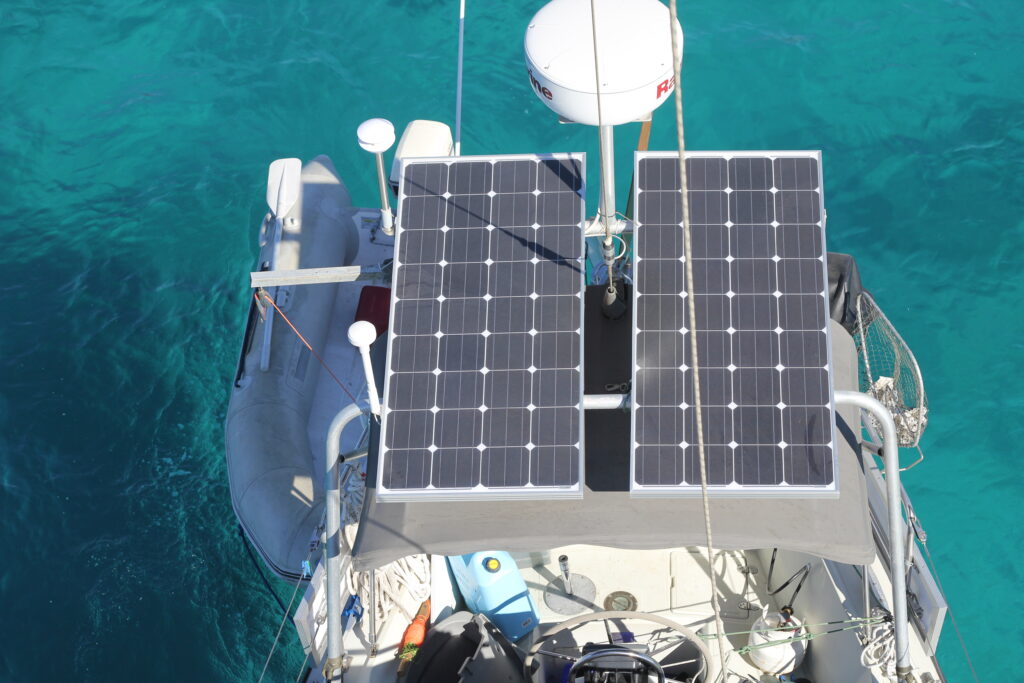
What is the purpose of a sailboat arch?
Structural arches, also commonly referred to as solar, stern, or radar arches, are a common feature of coastal cruising and bluewater sailboats .
They are used for a variety of purposes, but most commonly to mount and support:
- Solar panels
- A wind generator
- A radar radome
- A weather station
- Various communications antennae
- A dinghy davit, for raising and lowering the dinghy
What do sailboat solar arches cost?
While they provide many advantages, arches can often be prohibitively expensive (commonly from 5k – 12k); but with a little sweat equity, limited metal working skill, and some careful measurements there is no reason why you can’t build your own sturdy arch for a fraction of the normal cost.
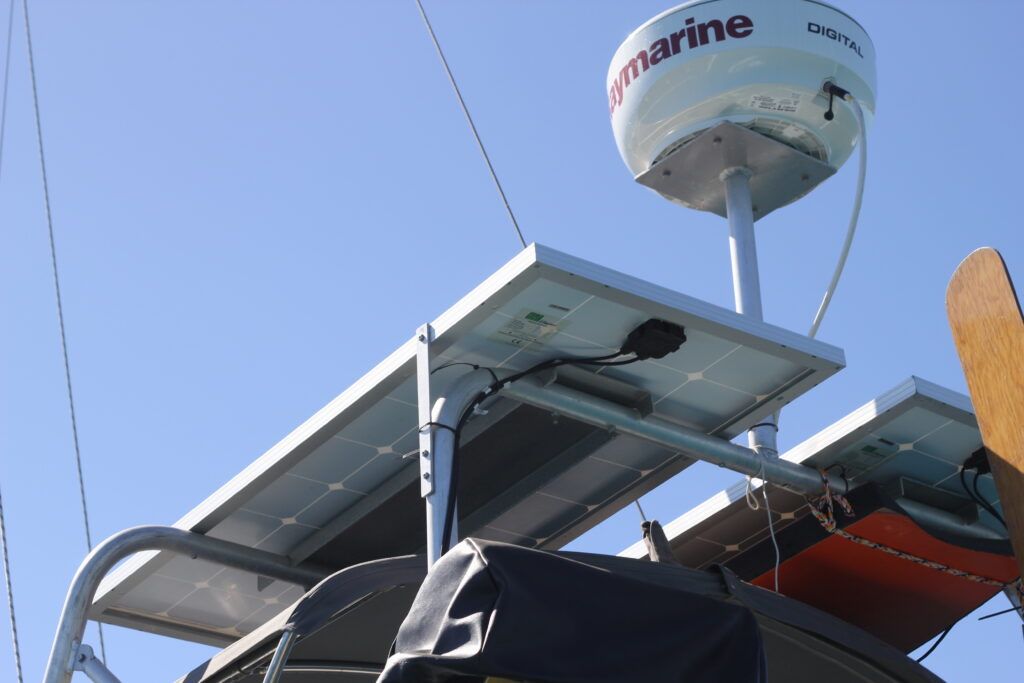
Customizing your solar arch
There are as many shapes and sizes of structural arches as there are sailboats. Determining the style of an arch for your sailboat will depend on a variety of factors, primarily; aesthetics, cost, and function.
This article details my experience designing, fabricating, and installing a simple, aluminum arch that I use for solar panels, radar, AIS antenna, and a weather station, not to mention a hundred other small things.
The principles of design and fabrication are common to a wide variety of arches and can likely be used as the basis for other who want to modify the design to fit their own needs and boat shape.
I provide very little engineering guidance below and I recommend that readers creating their own arches first pass their design by a structural engineer or someone knowledgeable in structural design.
There are three main types of material from which to construct an arch; stainless steel, aluminum, and fiberglass.
There are a variety of factors that go into material selection, with the most common being; aesthetics, price, strength, and ease of construction. I made a subjective traffic light comparison of the different materials, to assist our decision-making process.

Stainless steel and aluminum compared closely for our needs, but as our chief concerns were price and ease of construction we opted to go with aluminum.
There are many different grades of aluminum and it is important to select one that will stand up to the marine environment.
We selected aluminum alloy 5052. It is a medium-strength aluminum alloy with good ductility and excellent corrosion resistance and for the latter reason is often preferred for marine environments.
High-grade aluminum cannot be easily found in conventional building supply stores like Home Depot.
Purchasing metal from a wholesaler, such as Metal Supermarket or Metals Depot , is much cheaper than buying from a local welder or manufacturer. A simple google search will supply you with the options for metal wholesalers in your area.
We purchased our raw materials for the arch for around $70 USD.
In addition to the aluminum tubing, we required the same type of aluminum in flat-stock and stainless steel bolts and lock-nuts to fasten the frame together and to secure it to the deck of the boat.
I made all the required cuts with a hack-saw and jigsaw, though a metal cutting blade on a radial arm saw or circular saw would have worked as well.
I cleaned up the cut edges and any sharp spots with a 5” angle grinder with a grinding disc made for aluminum. A titanium-coated drill bit was used to make the bolt holes.
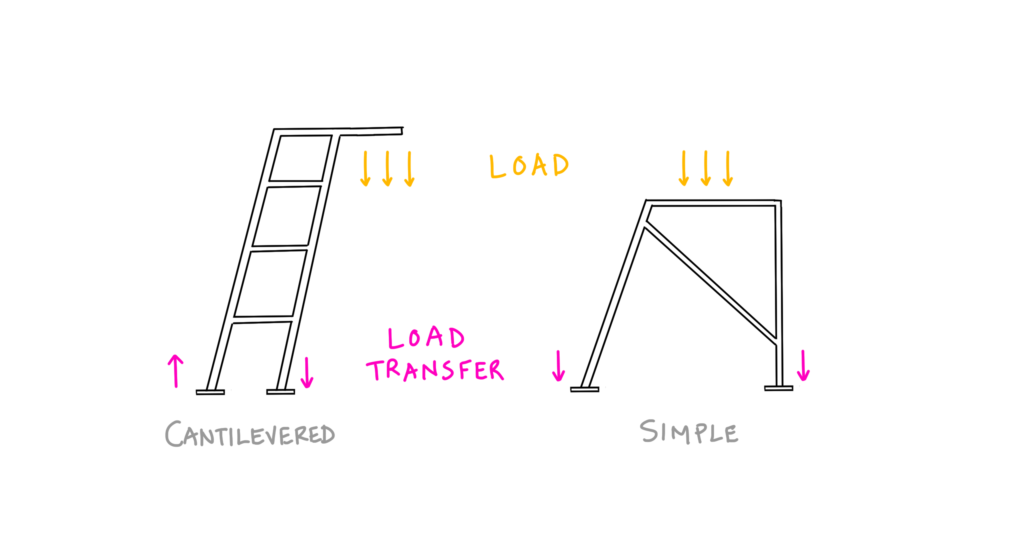
Determining the shape
Once the material was selected we had to decide on a shape. We wanted as simple and robust a shape as possible.
Many arches have a form that cantilevers over the transom of the boat. While the aesthetic is nice, the primary function of this shape is to support dinghy davits. Due to its cantilevered nature, it imparts a constant rotational force on the attachment locations.
We have a wind vane on the back of our boat, so hoisting the dinghy was out of the question. We opted for a simpler shape that transfers load straight down, thereby reducing stress on attachment locations.
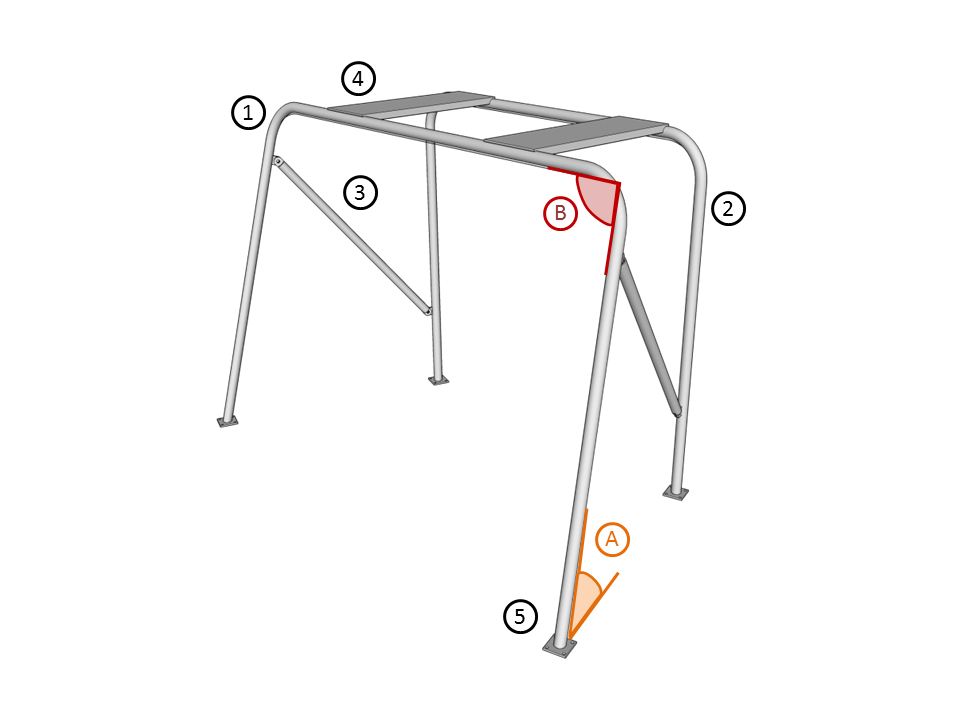
The arch design makes use of a forward tube (1) and an aft tube (2) with two bends in each tube. A tube connecting the aft and forward tubes at an angle creates a cross brace (3), resisting lateral force fore and aft and distributing dead load.
Two pieces of flat-stock aluminum (4) bolted on top of the forward and aft tubes also provide lateral resistance and further rigidity to the frame.
The 3” radius bends in the tubes resist lateral forces from the sides.
Four ¼” thick, 3” square plates (5) were cut from flat stock and welded to the ends of the tubes. These plates were bolted through the deck to matching plates on the other side.
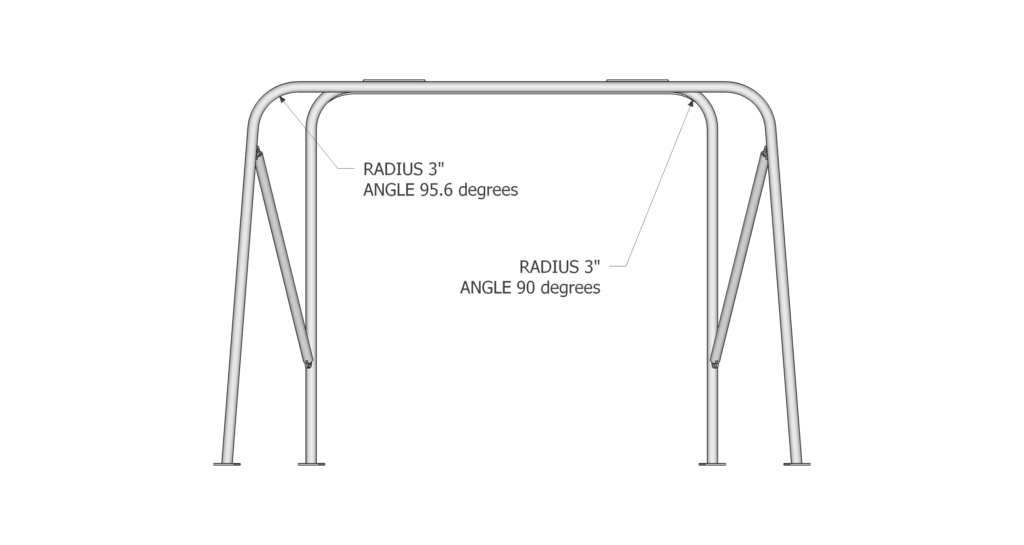
Calculating the tube bends
After measuring everything out to ensure no obstruction, the next step was determining the slope angle (A) of the forward tube. The slope of the tube would give the arch a sleeker look and improve access on and off the boat.
Wherever possible it is nice to create parallel lines as too many intersecting lines can be displeasing to the eye, so I maintained the same slope as the pushpit.
The slope of the forward tube (A) also determines the angle (B) at which the tube will be bent in order to keep the sides of the arch in one plane and in line with the sides of the boat.
There are three ways to calculate the angle of bend (B) in the forward tube:
The first requires some complex trigonometry for which I created a calculator in Excel, which requires only the dimensions of the arch as inputs.
Another option is to use a free CAD (computer-assisted drawing) program such as Trimble SketchUp and draw the arch you want to build using the measurements you took from the boat. If using CAD, it is a simple process to measure the angle of the bend with the protractor tool.
Lastly, you can construct the arch out of a practice material such as PVC pipe or doweling and physically measure the angles and dimensions. This option also provides the chance to see how the arch interacts with other components of the boat.
Tube bending
Bending the tubing can be done for a low cost at home. It is possible to rent a tube bender from a building supply store for $50 USD per day or purchase a hydraulic tube bender for around $100-150 USD.
We ended up renting a tube bender and found the process quite easy.
We were advised by a tube bending company (Aggressive Tube Bending) to select tubing with a 1.5” outer diameter and a 0.145” wall as it didn’t require annealing (heating and slowly cooling) to bend to a 3” radius, whereas 2” tubing would have required annealing.
It is a good idea to contact a metal shop or tube bending company to ensure that your design can be fabricated without special equipment or techniques.
Usually, these questions can be answered quickly and over the phone and do not incur a consulting fee.
Installation
Dry-fit preinstallation.
My recommendation would be to dry-fit everything prior to any welding.
It takes a little extra time to assemble and dry-install the arch, only to disassemble it again, but the time saved in having to cut welds or modify a finished product is well worth it.
We designed and installed our arch while dry-docked in a boatyard. We tried to keep the solar panels parallel to the waterline, but when the boat went back in the water, due to weight redistribution, the panels ended up angled slightly forward.
It is a good idea to fit the arch on a calm day at the dock, rather than guess how the boat sits in the water.
Measure and cut the tubes
The most difficult process of the whole job was transferring the angle of the deck to the bottom of the tubes to ensure that the base plates would be flush when mounted. Because the deck slopes in two directions it would be impossible to assume an angle at which to cut.
The solution we devised was using a piece of ½” wood and tracing around the tube with an indelible marker (see image below).
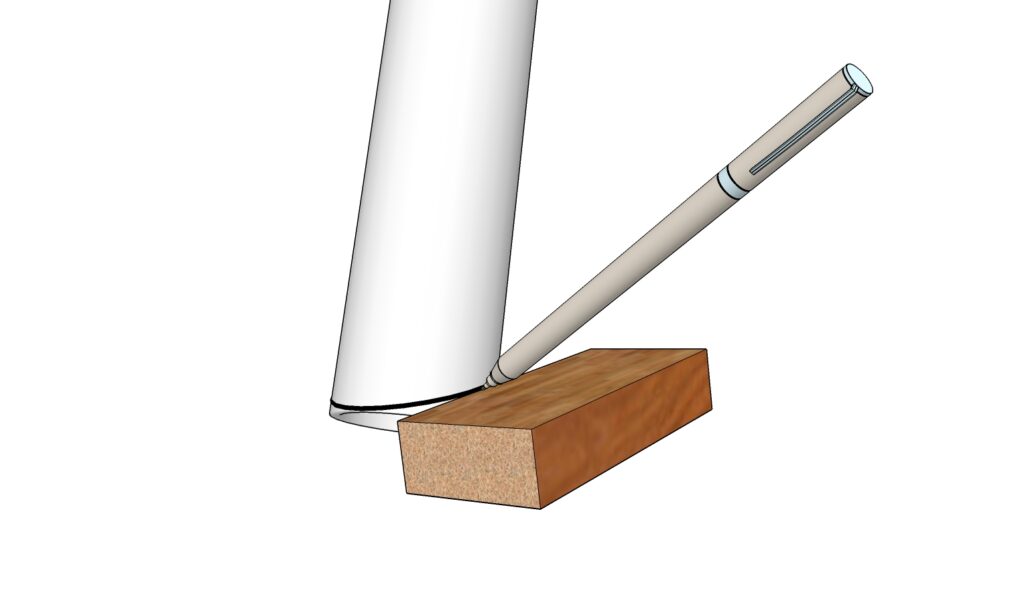
We first made the tubes as secure as possible in the locations they would be when they are bolted to the deck. This required installing the flat stock between them and lashing them to as many points on the deck as we could find.
The bottom of the tubes rested on the deck. We used a 3/8” thick, block of wood, which was placed flat on the deck, as a guide and traced a line around each tube.
The line transferred the correct angle of the deck to the tubes. I made the cuts with a hack saw and cleaned them up with an angle grinder.
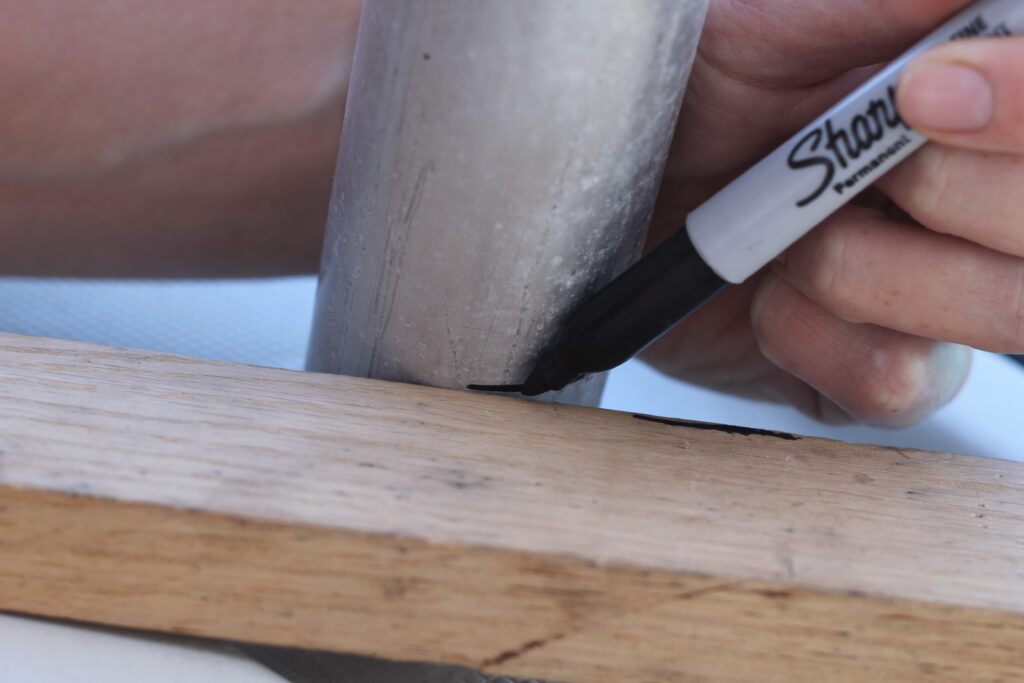
Weld base plates and attachment tabs
We hired an aluminum welder to weld 3”X3”X1/4” plates to the tubes that would be used to connect the arch to the deck of the boat.
When fitting the base plates to the tubing, trace the shape of the tube onto the baseplate to ensure the orientation of the plate is maintained.
We also welded tabs to the fore and aft tubes and corresponding tabs to the ends of the cross-brace tubes. The length of the cross-brace tube must be exact to connect to the attachment tabs on the fore and aft tubes, so careful measurements are required.
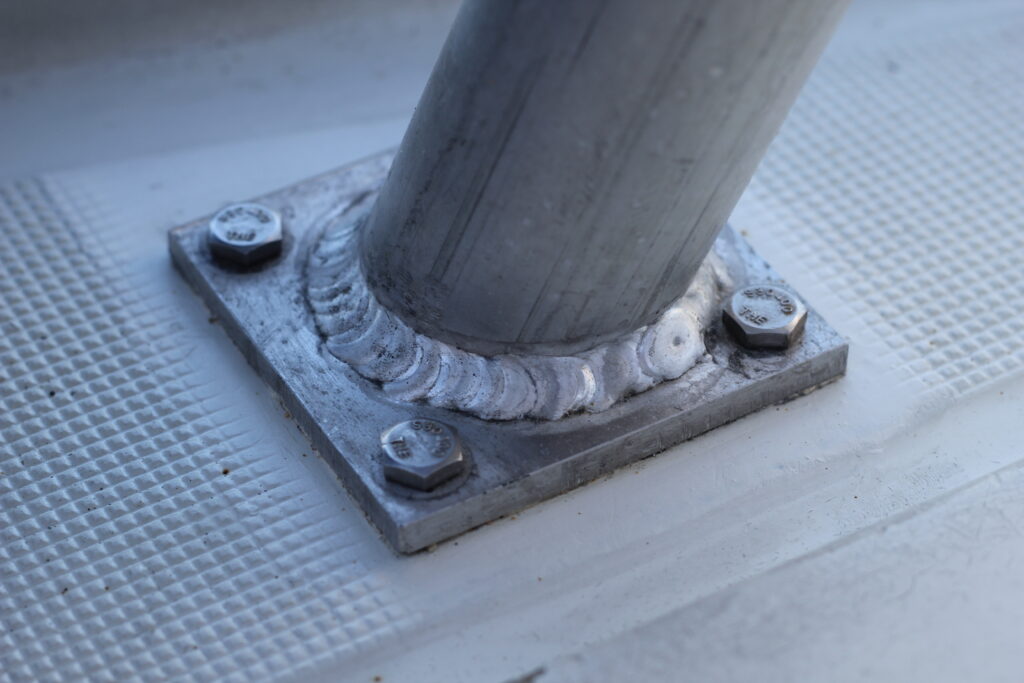
Install the fore and aft tubes
We bolted the fore and aft tubes to the deck prior to bolting together the rest of the frame.
We had planned to run the electrical cables for antennae and the radome through the tubes so we drilled 1” diameter holes in the base plates and through the deck where the base plates would be attached.
The 1” diameter hole will accommodate most electrical connectors. You may also want to install a ‘messenger line,’ which can be used to pull the cables through the frame after the arch is installed.
We applied Sikaflex 291 to the entire underside of the base plate immediately prior to installation to ensure a water-tight connection between the base plates and the deck.
The base plates were secured with 1.5” x 5/16” stainless steel bolts that connected to corresponding plates on the underside of the deck.
If there is not enough room for a plate on the underside, you can double up oversized stainless steel washers to meet the pull-out resistance requirements.
Stainless steel will react to aluminum and cause corrosion of the aluminum. A simple way to avoid this is to apply lanolin (we used Lanocote) to the stainless steel bolts to insulate them from the aluminum.
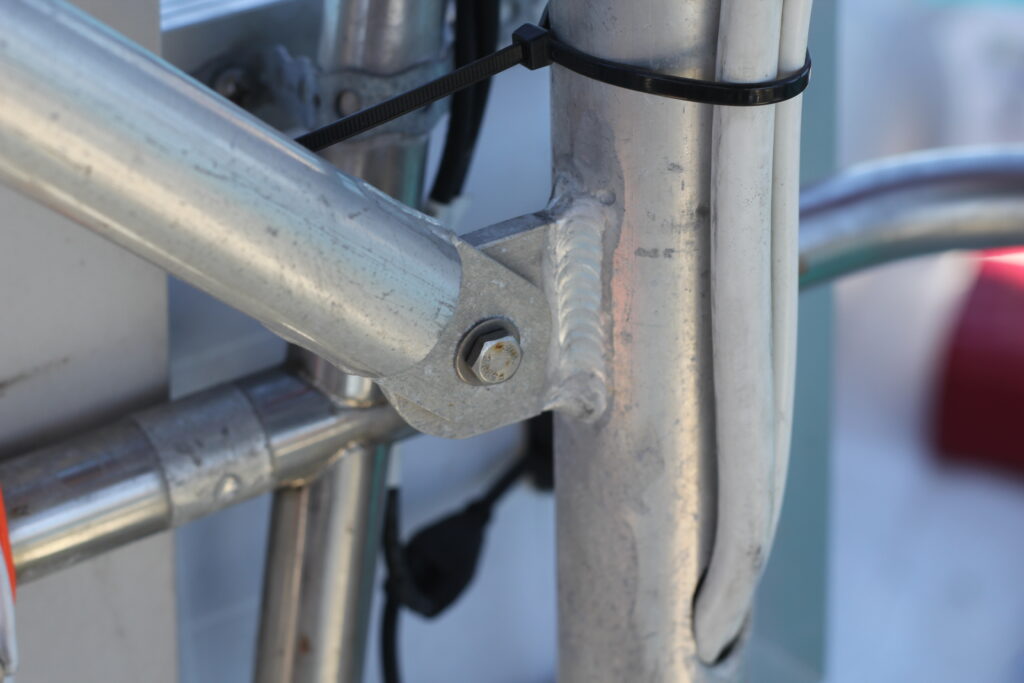
Bolt the frame together
Next we attached the cross-brace tubes. There will be a little flex in the frame, which provides some allowance for connecting the cross braces.
After securing the cross-brace tubes with stainless steel bolts, we installed the 1/4” flat stock to the tops of the tubes.
We had previously cut the flat stock into two 8” wide strips. If you are concerned about rigidity you can bend a 90-degree angle into the length of the flat-stock, though over a 3’ length, the deflection of unbent flat-stock will be minimal.
To improve corrosion resistance and the aesthetic appearance of the arch, the various pieces, now that they have been welded, can be anodized or painted.
Anodizing requires submersion in a shallow electrolytic bath, so the arch must be in its disassembled form in order to be anodized. We received a quote for $150 USD to anodize the arch in any color we wanted.
Another option is to have the arch powder coated. We received a quote of $100 to paint it white or black.
In the end, we opted to do nothing as we don’t mind the dull silver look of the aluminum and were still penny-pinching.
In retrospect, we wish we’d had the arch anodized bright orange, but we were in a rush and focused on keeping costs to a minimum.
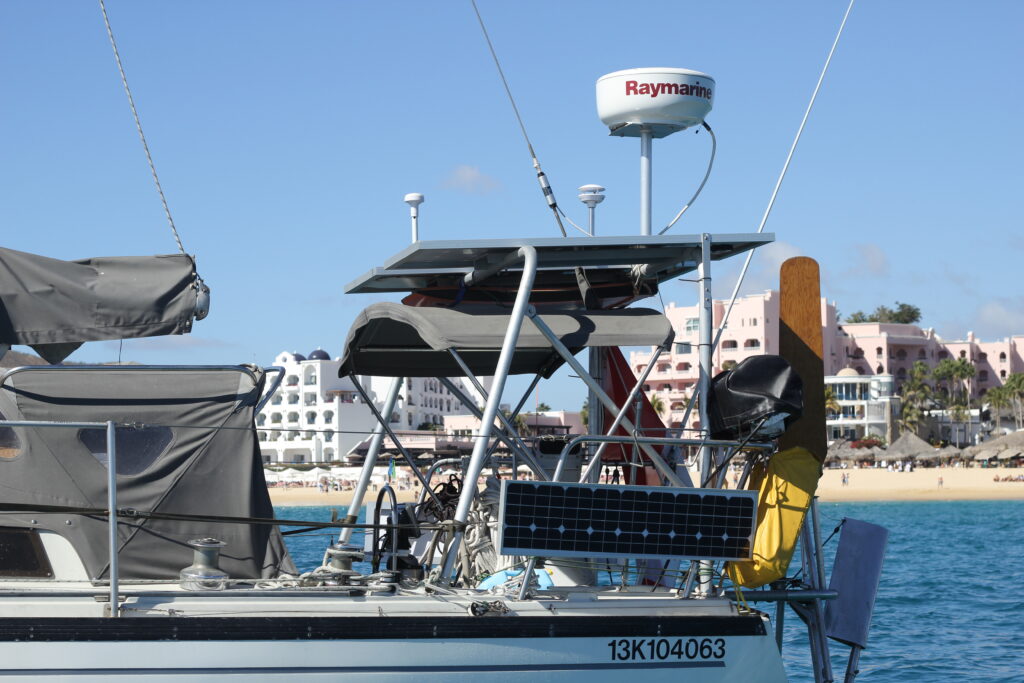
The arch has not only been extremely useful for its intended purpose but also become invaluable for the various add-ons that we could never have foreseen.
In addition to being a mount for solar panels, radome, communications antennae, and the weather station, an arch is also a place that supports or provides attachment points for:
- the outboard fuel tank and outboard lifting tackle
- fishing rod holders and a fish cleaning station
- the stern anchor
- furling line and boom brake attachment points
- boogie board storage
It also adds to the sense of security in the cockpit and is a great handhold in rolling conditions. It was a lot of work, but in the end, only costs us $200 USD and we can no longer imagine our little boat without it.
*Note: We installed our radome directly over the solar panels, which was a bad idea as it shades a small portion of the panels most of the time, greatly reducing solar output. I would recommend installing the arch on an extension away from the solar panels so that the noon-day sun is unobstructed, or even better, installing the radome on the mast.
Fiona McGlynn is an award-winning boating writer who created Waterborne as a place to learn about living aboard and traveling the world by sailboat. She has written for boating magazines including BoatUS, SAIL, Cruising World, and Good Old Boat. She’s also a contributing editor at Good Old Boat and BoatUS Magazine. In 2017, Fiona and her husband completed a 3-year, 13,000-mile voyage from Vancouver to Mexico to Australia on their 35-foot sailboat.
Terms and Conditions - Privacy Policy

IMAGES
VIDEO
COMMENTS
For example, the 21ft gaff-rigged cutter I'm currently building will end up costing between $33,000 and $35,000, fully outfitted—several thousand dollars more than the new prices of a couple of popular fiberglass boats near the same size. And yes, since it's wood, it will demand more maintenance.
The sailboat hull can be constructed in a step-by-step process. Here is how you can construct a strong and durable sailboat hull: Step 1. Create the hull mold: Start by building a robust and long-lasting frame that accurately represents the shape and size of the hull. Step 2.
Sailboats that you can build from home will likely be a small boat under 20 feet. These could be from many different boat suppliers such as B&B Yachts, Brooks Boat Designs, and Chase Small Craft. Boat plans will vary based on your budget and how much time you have on your hands. Based on my previous experience, building your own boat will take ...
Boat plans to help you build your dream. Since our first plans were sold for home construction in 1938, over 100,000 boats have been built from our plans. 0. ... Build your own boat with our tried and tested plans. Boat plans. Hartley Boats has the widest range of boat plans for sail boats, power boats, catamarans and trimarans, dinghys and ...
Let the primer coat dry completely as per instructions. Use a brush or roller to apply the desired paint color, starting from the top and working down. Allow the paint to dry between coats and apply more coats if needed. To varnish the sailboat, apply a thin and even coat in the direction of the wood grain.
Check out my Patreon to help support the boat build! - https://www.patreon.com/jackwood25Guten Morgen! After months of building and filming, I'm finally post...
Westhaven 32. $ 285.00 - $ 300.00 (USD) Build your own sail boat yatch from 9 feet to 63 feet in length. Fully featured wooden boat plans for home construction in Plywood, Steel and Fibre Glass.
The average price range for building a sailboat from scratch is between $10,000 and $20,000. A self-build kit for a 17' sailboat can be purchased for $2,500, while a sail-away Puur 17 kit can cost between $14,000 and $18,000. Meanwhile, building a 21ft gaff-rigged cutter can cost between $33,000 and $35,000. If you're building dinghies, you can ...
Here are the steps to follow when installing the cabin: Build the cabin on a flat surface using marine-grade plywood. Cut the cabin to fit the deck and hull and sand the edges to ensure a tight fit. Apply a layer of epoxy to the cabin and deck joint to seal it. Secure the cabin to the deck using screws or bolts.
Check out my Patreon to help support the boat build! - https://www.patreon.com/jackwood25こんにちは and welcome back to my channel. Sorry it's taken me so long to...
Building a wooden sailboat is a rewarding and fulfilling endeavor that allows you to create your own vessel for sailing adventures. Whether you're a seasoned sailor or a woodworking enthusiast, constructing a wooden sailboat requires careful planning, attention to detail, and a love for craftsmanship.
Here's the whole story, in words and pictures. How to Build a Boat: Part 1: The All-Important Preparation. Part 2: How to Build a Boat Hull in Western Red Cedar. Part 3: Sheathing the Hull in Woven Glass Rovings. Part 4: Cutting and Installing the Plywood Bulkheads. Part 5: Building the Interior Structure.
Every year, thousands of amateurs much like yourself build their own boats the proven Glen-L way. Many builders save 50% or more over the price of a factory-built boat. It's easier than you might think, and it can be a rewarding experience. Industry experts. 60+ Years. Established in 1953. 300+ Models.
Sailboats embody the mystery of the sea, of going only where the wind is willing to take you. We offer a variety of sailboat sizes, using several construction techniques. We offer sails, hardware and rigging for many of our sailboat designs. This enables you to focus on building your boat, not searching around for all the bits and pieces needed ...
Rather than buying an old junker with the intention of fixing it up (when you can find the time), consider building your own boat. James Wharram, a British multihull pioneer and designer of plywood Polynesian-style catamarans ranging from 14 to 55 feet, is now offering the Mana 24 as a complete kit for $13,500. ...
Skerry. Sailing Dinghies. Faering Cruiser. Kayak-Canoe Sailrig. Pacific Proas. Independence R/C Model. Our collection of sailboat kit designs from 8 to 31 feet. Strong, lightweight okoume plywood means strong, lightweight sailing craft. Most of our sailboats can be cartopped, all of them sail beautifully, and all of them are easy to build.
It costs mucho dinero. Thus, we introduce the Hobby Kat, sailboat plans, a build-it-yourself version of the "Hobie" that should cost from half to a third of the commercial version. If you have the moola, of course, go for a Hobie and have the time of. your life on the water. If not, try our Hobby. The homebuilt is not quite the same.
BUILDING A SAILBOAT from SCRATCH With NO Experience In Sailing Or Building - meet Mirco who made the impossible possible and shows us with his Aluminium Days...
Build Your Own Boat. Myboatplans 518 Boat Plans. By Kaycee Longmore on Wed, 20 Dec 2023 More Information. This program was created by Martin Reid for all boat enthusiasts and aspiring sailors who wish to be on the waters with their own boats. Martin is a master boat builder with 31 years' experience in this field.
Building your own sailboat. The feeling of opening a package with plans for your new sailboat is both exciting and frightening. You can't imagine what it will look like, how you'll build the mast from scratch or seal off all those little screws on deck hardware, but at least you have 10 pages worth of beautiful blueprints to stare at! ...
Build your own sailboat solar arch or radar arch for a fraction of the price. We were outfitting our 1979 Dufour 35 for a multi-year sailing trip and had decided to install a 400-watt solar array. But how to best mount them? A structural arch made the most sense, and we didn't have one. After a couple of quotes over $5000 USD for a 'simple ...
Just two small winches take care of headsail sheeting and swinging the keel plate up. There is enough weight in the keel to ensure the boat is self-righting.Next pick up a pre loved mast and some sails or choose from a variety of mast and sail options to suit your budget and sailing preferences. Your Elliott 22 DS is Fun to Build - Fun to Sail.
Build Your Sea Ray. Create and customize your perfect Sea Ray® boat, or simply take a closer look at your favorite model. Choose a series and build your own boat - select colors, propulsion, accessories and more. Once you've finished designing, you can save your personalized creation.